|
|
Dr. Janko Böhm
|

|
|
|
|
Research
|
|
|
Moduli Parameters of Complex Singularities with Non-Degenerate Newton Boundary
|
|
|
|
|
 Our recent extension of Arnold's classification includes all
singularities of corank up to two equivalent to a germ with a
non-degenerate Newton boundary, thus broadening the classification's
scope significantly by a class which is unbounded with respect to
modality and Milnor number. This method is based on proving that all
right-equivalence classes within a mu-constant stratum can be
represented by a single normal form derived from a regular basis of a
suitably selected special fiber. While both Arnold's and our preceding
work on normal forms addresses the determination of a normal form family
containing the given germ, this paper takes the next natural step: In arxiv.org/abs/2402.05093 we
present an algorithm for computing for a given germ the values of the
moduli parameters in its normal form family, that is, a normal form
equation in its stable equivalence class. This algorithm will be crucial
for understanding the moduli stacks of such singularities. The
implementation of this algorithm, along with the foundational
classification techniques, is implemented in the library arnold.lib for
the computer algebra system Singular.
Our recent extension of Arnold's classification includes all
singularities of corank up to two equivalent to a germ with a
non-degenerate Newton boundary, thus broadening the classification's
scope significantly by a class which is unbounded with respect to
modality and Milnor number. This method is based on proving that all
right-equivalence classes within a mu-constant stratum can be
represented by a single normal form derived from a regular basis of a
suitably selected special fiber. While both Arnold's and our preceding
work on normal forms addresses the determination of a normal form family
containing the given germ, this paper takes the next natural step: In arxiv.org/abs/2402.05093 we
present an algorithm for computing for a given germ the values of the
moduli parameters in its normal form family, that is, a normal form
equation in its stable equivalence class. This algorithm will be crucial
for understanding the moduli stacks of such singularities. The
implementation of this algorithm, along with the foundational
classification techniques, is implemented in the library arnold.lib for
the computer algebra system Singular.
This paper is joint work with Magdaleen
Marais and
Gerhard
Pfister.
|
|
|
|
|
Massively Parallel Modular Methods in Commutative Algebra and Algebraic Geometry |
|
|
|
|
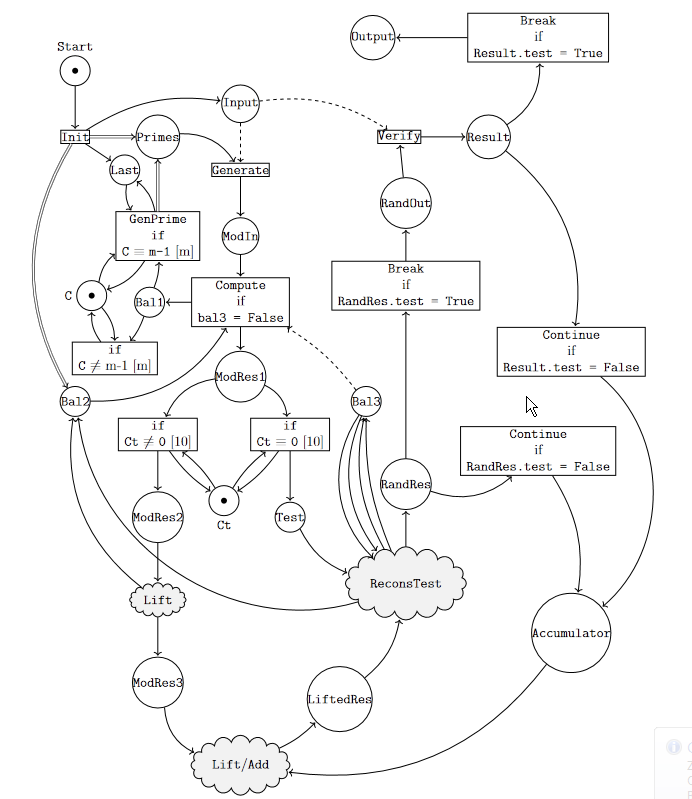 Computations over the rational numbers often encounter the problem of
intermediate coefficient growth. A solution to this is provided by
modular methods, which apply the algorithm under consideration modulo a
number of primes and then lift the results to the rationals. In arxiv.org/abs/2401.11606,
we present a
novel, massively parallel framework for modular computations with
polynomial data, which is able to cover a broad spectrum of applications
in commutative algebra and algebraic geometry. We demonstrate the
framework's effectiveness in Groebner basis computations over the
rationals and algorithmic methods from birational geometry. In
particular, we develop algorithms to compute images and domains of
rational maps, as well as determining invertibility and computing
inverses.
Computations over the rational numbers often encounter the problem of
intermediate coefficient growth. A solution to this is provided by
modular methods, which apply the algorithm under consideration modulo a
number of primes and then lift the results to the rationals. In arxiv.org/abs/2401.11606,
we present a
novel, massively parallel framework for modular computations with
polynomial data, which is able to cover a broad spectrum of applications
in commutative algebra and algebraic geometry. We demonstrate the
framework's effectiveness in Groebner basis computations over the
rationals and algorithmic methods from birational geometry. In
particular, we develop algorithms to compute images and domains of
rational maps, as well as determining invertibility and computing
inverses.
Our implementation is based on the Singular/GPI-Space framework,
which uses the computer algebra system Singular as computational
backend, while coordination and communication of parallel computations
is handled by the workflow management system GPI-Space, which relies on
Petri nets as its mathematical modeling language. Convenient
installation is realized through the package manager Spack. Relying on
Petri nets, our approach provides automated parallelization and
balancing of the load between computation, lifting, stabilization
testing, and potential verification. We use error tolerant rational
reconstruction to ensure termination as long as for a fixed computation
there exist only finitely many bad primes. Via stabilization testing,
our approach automatically finds with high probablity a minimal set of
primes required for the successful reconstruction.
We present timings to illustrate the potential for a game changing
improvement of performance over previous modular and non-modular
methods. In particular, we illustrate that the approach scales very well
with the number of processor cores used for the computation.
This paper is joint work with Dirk
Basson, Magdaleen
Marais, Mirko
Rahn, and Patrick
Rakotoarisoa.
|
|
|
|
Commutative Algebra and Algebraic Geometry using OSCAR
Chapter
in "The Computer Algebra System OSCAR" |
|
|
|
|
 In the paper arxiv.org/abs/2404.12085
(in The
Computer Algebra System OSCAR) we give illustrative examples of how the computer algebra system OSCAR can
support research in commutative algebra and algebraic geometry. We
start with a thorough introduction to Groebner basis techniques, with
particular emphasis on the computation of syzygies, then apply these
techniques to deal with ideal and ring theoretic concepts such as
primary decomposition and normalization, and finally use them for
geometric case studies which concern curves and surfaces, both from a
local and global point of view.
In the paper arxiv.org/abs/2404.12085
(in The
Computer Algebra System OSCAR) we give illustrative examples of how the computer algebra system OSCAR can
support research in commutative algebra and algebraic geometry. We
start with a thorough introduction to Groebner basis techniques, with
particular emphasis on the computation of syzygies, then apply these
techniques to deal with ideal and ring theoretic concepts such as
primary decomposition and normalization, and finally use them for
geometric case studies which concern curves and surfaces, both from a
local and global point of view.
This paper is joint work with Wolfram
Decker, and Frank-Olaf
Schreyer.
|
|
|
|
Algorithms for Gromov-Witten Invariants of Elliptic Curves
Chapter
in "The Computer Algebra System OSCAR" |
|
|
|
|
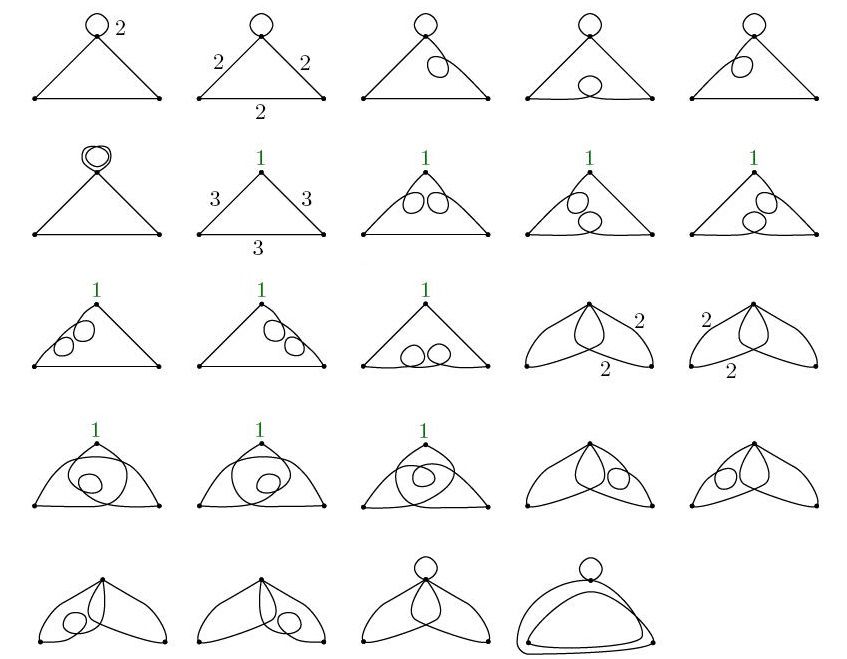 In the paper arxiv.org/abs/2311.11381
(in The
Computer Algebra System OSCAR), we
present an enhanced algorithm for exploring mirror symmetry for
elliptic curves through the correspondence of algebraic and tropical
geometry, focusing on Gromov-Witten invariants of elliptic curves and,
in particular, Hurwitz numbers. We present a new highly efficient
algorithm for computing generating series for these numbers. We have
implemented the algorithm both using Singular and OSCAR. The
implementations outperform by far the current method provided in
Singular. The OSCAR implementation, benefiting in particular from
just-in-time compilation, again by far outperforms the implementation of
the new algorithm in Singular. This advancement in computing the
Gromov-Witten invariants facilitates a study of number theoretic and
geometric properties of the generating series, including
quasi-modularity and homogeneity.
In the paper arxiv.org/abs/2311.11381
(in The
Computer Algebra System OSCAR), we
present an enhanced algorithm for exploring mirror symmetry for
elliptic curves through the correspondence of algebraic and tropical
geometry, focusing on Gromov-Witten invariants of elliptic curves and,
in particular, Hurwitz numbers. We present a new highly efficient
algorithm for computing generating series for these numbers. We have
implemented the algorithm both using Singular and OSCAR. The
implementations outperform by far the current method provided in
Singular. The OSCAR implementation, benefiting in particular from
just-in-time compilation, again by far outperforms the implementation of
the new algorithm in Singular. This advancement in computing the
Gromov-Witten invariants facilitates a study of number theoretic and
geometric properties of the generating series, including
quasi-modularity and homogeneity.
This paper is joint work with Alain
Hoffmann, Firoozeh Dastur, Hannah
Markwig and Ali
Traore.
|
|
|
|
Algorithms for GIT-fans of Affine Torus Actions
Chapter
in "The Computer Algebra System OSCAR" |
|
|
|
|
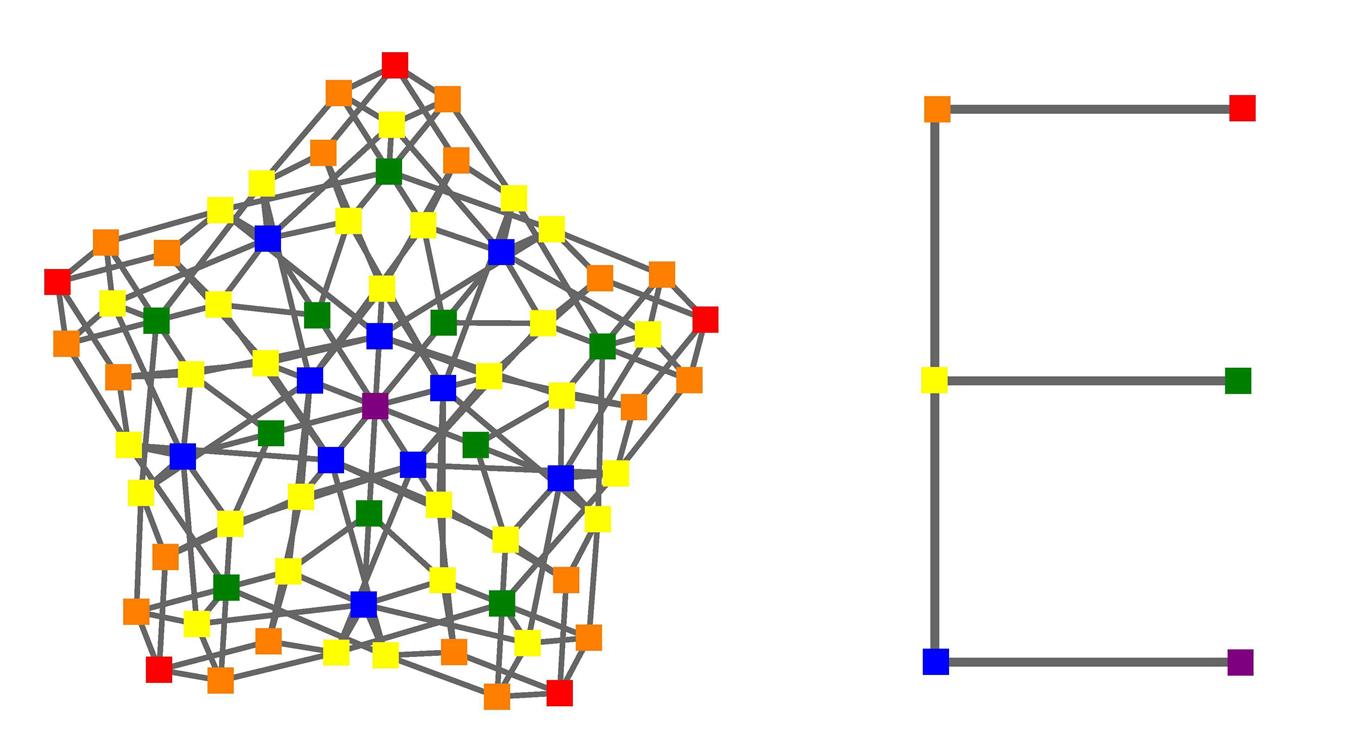 The GIT-fan assigned to an algebraic variety with the action of an algebraic
group is a polyhedral fan enumerating all GIT-quotients
in the sense of Mumford. In this paper (in The
Computer Algebra System OSCAR), we discuss
an algorithm to compute the GIT-fan for torus actions
on affine varieties with finite symmetries, and its
implementation in OSCAR. Relying on Gröbner basis
techniques to decide monomial containment, computations
with rational polyhedral cones, and expanding orbits
with respect to actions of permutation groups, the algorithm
combines computational methods from commutative algebra,
convex geometry and group theory. Consequently, OSCAR,
for the first time, provides an open-source framework
that seamlessly manages every stage of the algorithm.
We illustrate the algorithm through examples.
The GIT-fan assigned to an algebraic variety with the action of an algebraic
group is a polyhedral fan enumerating all GIT-quotients
in the sense of Mumford. In this paper (in The
Computer Algebra System OSCAR), we discuss
an algorithm to compute the GIT-fan for torus actions
on affine varieties with finite symmetries, and its
implementation in OSCAR. Relying on Gröbner basis
techniques to decide monomial containment, computations
with rational polyhedral cones, and expanding orbits
with respect to actions of permutation groups, the algorithm
combines computational methods from commutative algebra,
convex geometry and group theory. Consequently, OSCAR,
for the first time, provides an open-source framework
that seamlessly manages every stage of the algorithm.
We illustrate the algorithm through examples.
This paper is joint work with Thomas
Breuer.
|
|
|
|
|
NeatIBP 1.0, A package generating
small-size integration-by-parts relations for Feynman integrals
|
|
|
|
|
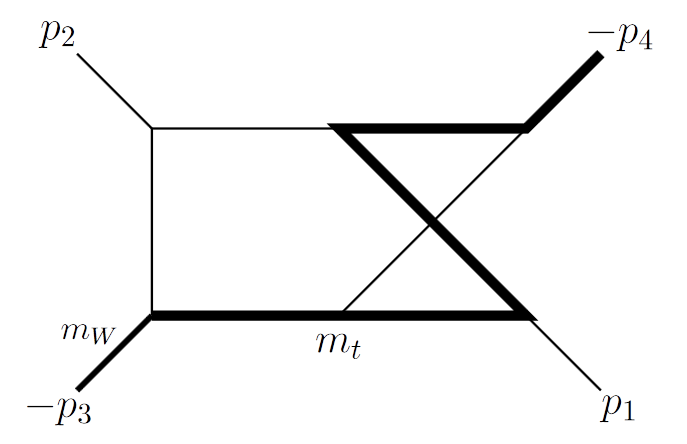 In the paper arxiv.org/abs/2305.08783
(Computer
Physics Communications Vol. 295, 2024, 108999), we present the package NeatIBP, which automatically
generates small-size integration-by-parts (IBP) identities for Feynman
integrals. Based on the syzygy and module intersection techniques, the
generated IBP identities' propagator degree is controlled and thus the
size of the system of IBP identities is shorter than that generated by
the standard Laporta algorithm. This package is powered by the computer
algebra systems Mathematica and Singular, and the library
SpaSM. It is parallelized on the level of Feynman integral
sectors. The generated small-size IBP identities can subsequently be
used for either finite field reduction or analytic reduction. We
demonstrate the capabilities of this package on several multi-loop IBP
examples.
In the paper arxiv.org/abs/2305.08783
(Computer
Physics Communications Vol. 295, 2024, 108999), we present the package NeatIBP, which automatically
generates small-size integration-by-parts (IBP) identities for Feynman
integrals. Based on the syzygy and module intersection techniques, the
generated IBP identities' propagator degree is controlled and thus the
size of the system of IBP identities is shorter than that generated by
the standard Laporta algorithm. This package is powered by the computer
algebra systems Mathematica and Singular, and the library
SpaSM. It is parallelized on the level of Feynman integral
sectors. The generated small-size IBP identities can subsequently be
used for either finite field reduction or analytic reduction. We
demonstrate the capabilities of this package on several multi-loop IBP
examples.
This paper is joint work with Zihao
Wu, Rourou
Ma, Hefeng
Xu, and Yang Zhang.
|
|
|
|
|
Geometric Algebra and Algebraic Geometry of Loop and Potts Models |
|
|
|
|
 In the paper arxiv.org/abs/2202.02986
(Journal
of High Energy Physics 05 (2022) 68, 66 pp) we uncover a connection between two seemingly separate subjects
in integrable models: the representation theory of the affine
Temperley-Lieb algebra, and the algebraic structure of solutions to the
Bethe equations of the XXZ spin chain. We study the solutions of Bethe
equations analytically by computational algebraic geometry, and find
that the solution space encodes rich information about the
representation theory of the Temperley-Lieb algebra. Using these
connections, we compute the partition function of the completely-packed
loop model and of the, closely related, random-cluster Potts model on
medium-size lattices with toroidal boundary conditions by two quite
different methods. We consider the partial thermodynamic limit of
infinitely long tori and analyze the corresponding condensation curves
of the zeros of the partition functions. Two components of these curves
are obtained analytically in the full thermodynamic limit.
In the paper arxiv.org/abs/2202.02986
(Journal
of High Energy Physics 05 (2022) 68, 66 pp) we uncover a connection between two seemingly separate subjects
in integrable models: the representation theory of the affine
Temperley-Lieb algebra, and the algebraic structure of solutions to the
Bethe equations of the XXZ spin chain. We study the solutions of Bethe
equations analytically by computational algebraic geometry, and find
that the solution space encodes rich information about the
representation theory of the Temperley-Lieb algebra. Using these
connections, we compute the partition function of the completely-packed
loop model and of the, closely related, random-cluster Potts model on
medium-size lattices with toroidal boundary conditions by two quite
different methods. We consider the partial thermodynamic limit of
infinitely long tori and analyze the corresponding condensation curves
of the zeros of the partition functions. Two components of these curves
are obtained analytically in the full thermodynamic limit.
This paper is joint work with Jesper Lykke Jacobsen, Yunfeng Jiang, and Yang Zhang.
|
|
|
|
|
Massively Parallel Computations in Algebraic Geometry
|
|
|
|
|
|
|
|
|
pfd-parallel, a Singular/GPI-Space package for massively parallel multivariate partial fractioning |
|
|
|
|
 Multivariate partial fractioning is a powerful tool for simplifying
rational function coefficients in scattering amplitude computations.
Since current research problems lead to large sets of complicated
rational functions, performance of the partial fractioning as well as
size of the obtained expressions are a prime concern. In
arxiv.org/abs/2104.06866
(Computer
Physics Communications Vol. 294, 2024, 108942),
we develop a large
scale parallel framework
pfd-parallel for multivariate partial fractioning, which
implements and combines an improved version of Leinartas' algorithm and
the MultivariateApart algorithm. Our approach relies only on open
source software. It combines parallelism over the different rational
function coefficients with parallelism for individual expressions. The
implementation is based on the Singular/GPI-Space framework for massively parallel computer algebra, which formulates
parallel algorithms in terms of Petri nets. The modular nature of this
approach allows for easy incorporation of future algorithmic
developments into our package. We demonstrate the performance of our
framework by simplifying expressions arising from current multiloop
scattering amplitude problems. We discover
that the compression ratio increases with the complexity of the Feynman
integrals. See here
for the analytic result.
Multivariate partial fractioning is a powerful tool for simplifying
rational function coefficients in scattering amplitude computations.
Since current research problems lead to large sets of complicated
rational functions, performance of the partial fractioning as well as
size of the obtained expressions are a prime concern. In
arxiv.org/abs/2104.06866
(Computer
Physics Communications Vol. 294, 2024, 108942),
we develop a large
scale parallel framework
pfd-parallel for multivariate partial fractioning, which
implements and combines an improved version of Leinartas' algorithm and
the MultivariateApart algorithm. Our approach relies only on open
source software. It combines parallelism over the different rational
function coefficients with parallelism for individual expressions. The
implementation is based on the Singular/GPI-Space framework for massively parallel computer algebra, which formulates
parallel algorithms in terms of Petri nets. The modular nature of this
approach allows for easy incorporation of future algorithmic
developments into our package. We demonstrate the performance of our
framework by simplifying expressions arising from current multiloop
scattering amplitude problems. We discover
that the compression ratio increases with the complexity of the Feynman
integrals. See here
for the analytic result.
This paper is joint work with Dominik
Bendle, Murray
Heymann, Mirko
Rahn, Lukas
Ristau, Marcel Wittmann, Zihao Wu, Yingxuan Xu
and Yang Zhang.
|
|
|
|
|
Classification of Complex Singularities with Non-Degenerate Newton Boundary
|
|
|
|
|
 In his groundbreaking work on classification of singularities
with regard to right and stable equivalence of germs, Arnold has listed
normal forms for all isolated hypersurface singularities over the
complex numbers with either modality less than or equal to two or Milnor
number less than or equal to 16. Moreover, he has described an
algorithmic classifier, which determines the type of a given such
singularity. In the paper arxiv.org/abs/2010.10185, we extend Arnold's work to a large
class of singularities which is unbounded with regard to modality and
Milnor number. We develop an algorithmic classifier, which determines a
normal form for any singularity with corank less than or equal to two
which is equivalent to a germ with non-degenerate Newton boundary in the
sense of Kouchnirenko. In order to realize the classifier, we prove a
normal form theorem: Suppose K is a mu-constant stratum of the jet space
which contains a germ with a non-degenerate Newton boundary. We first
observe that all germs in K are equivalent to some germ with the same
fixed non-degenerate Newton boundary. We then prove that all
right-equivalence classes of germs in K can be covered by a single
normal form obtained from a regular basis of an appropriately chosen
special fiber. All algorithms are implemented in the library arnold.lib
for the computer algebra system Singular.
In his groundbreaking work on classification of singularities
with regard to right and stable equivalence of germs, Arnold has listed
normal forms for all isolated hypersurface singularities over the
complex numbers with either modality less than or equal to two or Milnor
number less than or equal to 16. Moreover, he has described an
algorithmic classifier, which determines the type of a given such
singularity. In the paper arxiv.org/abs/2010.10185, we extend Arnold's work to a large
class of singularities which is unbounded with regard to modality and
Milnor number. We develop an algorithmic classifier, which determines a
normal form for any singularity with corank less than or equal to two
which is equivalent to a germ with non-degenerate Newton boundary in the
sense of Kouchnirenko. In order to realize the classifier, we prove a
normal form theorem: Suppose K is a mu-constant stratum of the jet space
which contains a germ with a non-degenerate Newton boundary. We first
observe that all germs in K are equivalent to some germ with the same
fixed non-degenerate Newton boundary. We then prove that all
right-equivalence classes of germs in K can be covered by a single
normal form obtained from a regular basis of an appropriately chosen
special fiber. All algorithms are implemented in the library arnold.lib
for the computer algebra system Singular.
This paper is joint work with Magdaleen
Marais and
Gerhard
Pfister.
|
|
|
|
|
Module Intersection for the Integration-by-Parts Reduction of Multi-Loop Feynman Integrals |
|
|
|
|
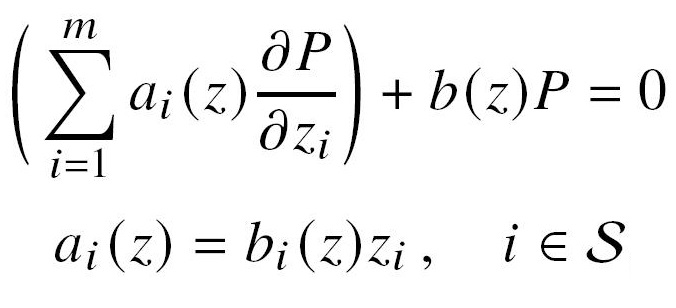 In
the manuscript arxiv.org/abs/2010.06895
(Proceedings of the
Conference "MathemAmplitudes 2019" in Padova, Italy,
PoS
- Proceedings
of Science MA2019 004 (2022), 19pp) we provide an
overview of the module intersection method for the the
integration-by-parts (IBP) reduction of multi-loop Feynman integrals.
The module intersection method, based on computational algebraic
geometry, is a highly efficient way of getting IBP relations without
double propagator or with a bound on the highest propagator degree. In
this manner, trimmed IBP systems which are much shorter than the
traditional ones can be obtained. We apply the modern, Petri net based,
workflow management system GPI-Space in combination with the computer
algebra system Singular to solve the trimmed IBP system via
interpolation and efficient parallelization. We show, in particular, how
to use the new plugin feature of GPI-Space to manage a global state of
the computation and to efficiently handle mutable data. Moreover, a
Mathematica interface to generate IBPs with restricted propagator
degree, which is based on module intersection, is presented in this
review.
In
the manuscript arxiv.org/abs/2010.06895
(Proceedings of the
Conference "MathemAmplitudes 2019" in Padova, Italy,
PoS
- Proceedings
of Science MA2019 004 (2022), 19pp) we provide an
overview of the module intersection method for the the
integration-by-parts (IBP) reduction of multi-loop Feynman integrals.
The module intersection method, based on computational algebraic
geometry, is a highly efficient way of getting IBP relations without
double propagator or with a bound on the highest propagator degree. In
this manner, trimmed IBP systems which are much shorter than the
traditional ones can be obtained. We apply the modern, Petri net based,
workflow management system GPI-Space in combination with the computer
algebra system Singular to solve the trimmed IBP system via
interpolation and efficient parallelization. We show, in particular, how
to use the new plugin feature of GPI-Space to manage a global state of
the computation and to efficiently handle mutable data. Moreover, a
Mathematica interface to generate IBPs with restricted propagator
degree, which is based on module intersection, is presented in this
review.
This paper is joint work with Dominik
Bendle, Wolfram
Decker, Alessandro Georgoudis,
Franz-Josef Pfreundt,
Mirko
Rahn, and Yang Zhang.
|
|
|
|
|
IBP reduction coefficients made simple |
|
|
|
|
 In the paper arxiv.org/abs/2008.13194 (Journal
of High Energy Physics (2020) 54, 39 pp)
we
present an efficient method to shorten the analytic
integration-by-parts (IBP) reduction coefficients of multi-loop Feynman
integrals. For our approach, we develop an improved version of
Leinartas' multivariate partial fraction algorithm, and provide a modern
implementation based on the computer algebra system Singular.
Furthermore, We observe that for an integral basis with uniform
transcendental (UT) weights, the denominators of IBP reduction
coefficients with respect to the UT basis are either symbol letters or
polynomials purely in the spacetime dimension D.
With a UT basis, the partial fraction algorithm is more efficient both
with respect to its performance and the size reduction. We show that in
complicated examples with existence of a UT basis, the IBP reduction
coefficients size can be reduced by a factor of as large as ~100. We observe that our algorithm also works well for settings without a UT basis.
In the paper arxiv.org/abs/2008.13194 (Journal
of High Energy Physics (2020) 54, 39 pp)
we
present an efficient method to shorten the analytic
integration-by-parts (IBP) reduction coefficients of multi-loop Feynman
integrals. For our approach, we develop an improved version of
Leinartas' multivariate partial fraction algorithm, and provide a modern
implementation based on the computer algebra system Singular.
Furthermore, We observe that for an integral basis with uniform
transcendental (UT) weights, the denominators of IBP reduction
coefficients with respect to the UT basis are either symbol letters or
polynomials purely in the spacetime dimension D.
With a UT basis, the partial fraction algorithm is more efficient both
with respect to its performance and the size reduction. We show that in
complicated examples with existence of a UT basis, the IBP reduction
coefficients size can be reduced by a factor of as large as ~100. We observe that our algorithm also works well for settings without a UT basis.
This paper is joint work with Marcel Wittmann, Zihao Wu, Yingxuan Xu, and Yang Zhang.
|
|
|
|
|
Parallel Computation of tropical
varieties, their positive part, and tropical Grassmannians
|
|
|
|
|
 In the paper arxiv.org/abs/2003.13752
we present a massively parallel framework for computing
tropicalizations of algebraic varieties which can make
use of finite symmetries. We compute the tropical Grassmannian
TGr0(3,8),
and show that it refines the 15-dimensional skeleton
of the Dressian Dr(3,8) with the exception of 23 special
cones for which we construct explicit obstructions to
the realizability of their tropical linear spaces. Moreover,
we propose algorithms for identifying maximal-dimensional
tropical cones which belong to the positive tropicalization.
These algorithms exploit symmetries of the tropical
variety even though the positive tropicalization need
not be symmetric. We compute the maximal-dimensional
cones of the positive Grassmannian TGr+(3,8)
and compare them to the cluster complex of the classical
Grassmannian Gr(3,8).
In the paper arxiv.org/abs/2003.13752
we present a massively parallel framework for computing
tropicalizations of algebraic varieties which can make
use of finite symmetries. We compute the tropical Grassmannian
TGr0(3,8),
and show that it refines the 15-dimensional skeleton
of the Dressian Dr(3,8) with the exception of 23 special
cones for which we construct explicit obstructions to
the realizability of their tropical linear spaces. Moreover,
we propose algorithms for identifying maximal-dimensional
tropical cones which belong to the positive tropicalization.
These algorithms exploit symmetries of the tropical
variety even though the positive tropicalization need
not be symmetric. We compute the maximal-dimensional
cones of the positive Grassmannian TGr+(3,8)
and compare them to the cluster complex of the classical
Grassmannian Gr(3,8).
This paper is joint work with Dominik
Bendle, Yue Ren, and Benjamin
Schröter.
|
|
|
|
|
Random growth on a Ramanujan graph
|
|
|
|
|
 In the paper arxiv.org/abs/1908.09575
the behavior of the randomized breadth-first search algorithm is analyzed on
arbitrary regular and non-regular graphs. Our argument is based on the expander
mixing lemma, which entails that the results are strongest for Ramanujan
graphs, which asymptotically maximize the spectral gap. We compare our
theoretical results with computational experiments on flip graphs of point
configurations. The latter is relevant for enumerating triangulations.
In the paper arxiv.org/abs/1908.09575
the behavior of the randomized breadth-first search algorithm is analyzed on
arbitrary regular and non-regular graphs. Our argument is based on the expander
mixing lemma, which entails that the results are strongest for Ramanujan
graphs, which asymptotically maximize the spectral gap. We compare our
theoretical results with computational experiments on flip graphs of point
configurations. The latter is relevant for enumerating triangulations.
This paper is joint work with Michael
Joswig, Lars
Kastner, and Andrew
Newman.
|
|
|
|
|
Integration-by-parts reductions of Feynman integrals using Singular and GPI-Space |
|
|
|
|
 In the paper arxiv.org/abs/1908.04301
(Journal
of High Energy Physics 02 (2020) 79, 34 pp)
we introduce an algebro-geometrically motived integration-by-parts (IBP)
reduction method for multi-loop and multi-scale Feynman integrals, using a
framework for massively parallel computations in computer algebra. This
framework combines the computer algebra system Singular with the workflow
management system GPI-Space, which is being developed at the Fraunhofer
Institute for Industrial Mathematics (ITWM). In our approach, the IBP relations
are first trimmed by modern algebraic geometry tools and then solved by sparse
linear algebra and our new interpolation methods. These steps are efficiently
automatized and automatically parallelized by modeling the algorithm in
GPI-Space using the language of Petri-nets. We demonstrate the potential of our
method at the nontrivial example of reducing two-loop five-point nonplanar
double-pentagon integrals. We also use GPI-Space to convert the basis of IBP
reductions, and discuss the possible simplification of IBP coefficients in a
uniformly transcendental basis.
In the paper arxiv.org/abs/1908.04301
(Journal
of High Energy Physics 02 (2020) 79, 34 pp)
we introduce an algebro-geometrically motived integration-by-parts (IBP)
reduction method for multi-loop and multi-scale Feynman integrals, using a
framework for massively parallel computations in computer algebra. This
framework combines the computer algebra system Singular with the workflow
management system GPI-Space, which is being developed at the Fraunhofer
Institute for Industrial Mathematics (ITWM). In our approach, the IBP relations
are first trimmed by modern algebraic geometry tools and then solved by sparse
linear algebra and our new interpolation methods. These steps are efficiently
automatized and automatically parallelized by modeling the algorithm in
GPI-Space using the language of Petri-nets. We demonstrate the potential of our
method at the nontrivial example of reducing two-loop five-point nonplanar
double-pentagon integrals. We also use GPI-Space to convert the basis of IBP
reductions, and discuss the possible simplification of IBP coefficients in a
uniformly transcendental basis.
This paper is joint work with Dominik
Bendle, Wolfram
Decker, Alessandro Georgoudis,
Franz-Josef Pfreundt,
Mirko
Rahn, Pascal Wasser, and Yang Zhang.
|
|
|
|
|
Counts of (tropical) curves in E×P1 and Feynman integrals
|
|
|
|
|
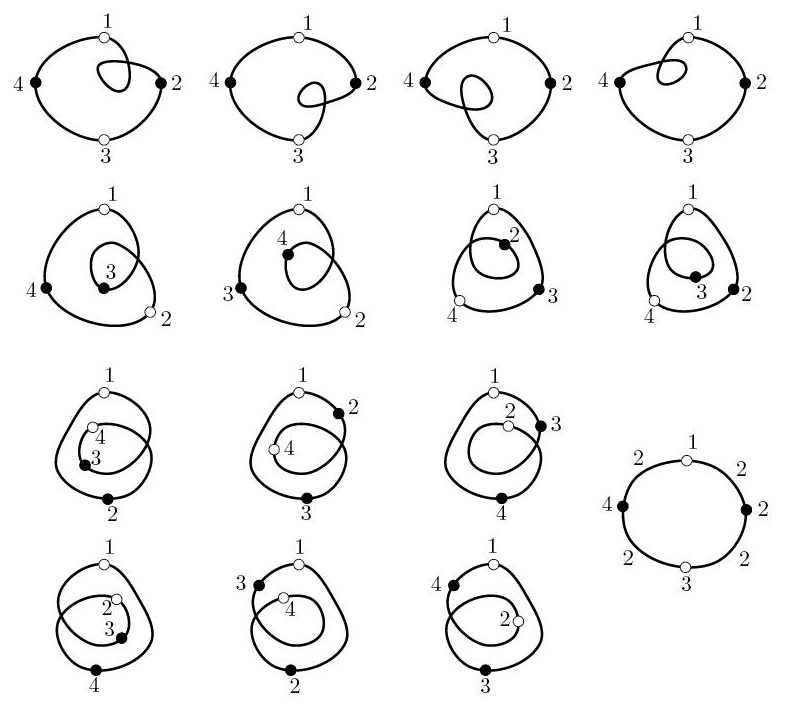 In the paper arxiv.org/abs/1812.04936
(Annales de l’Institut Henri Poincaré D,
Comb. Phys. Interact. 9 (2022), 121-158)
we study generating series of Gromov-Witten invariants of the
product of an elliptic curve E with projective 1-space
and their tropical counterparts. Using tropical degeneration and floor
diagram techniques, we can express the generating series as sums of
Feynman integrals, where each summand corresponds to a certain type of
graph which we call a pearl chain. The individual summands are - just as
in the case of mirror symmetry of elliptic curves, where the generating
series of Hurwitz numbers equals a sum of Feynman integrals - complex
analytic path integrals involving a product of propagators (equal to the
Weierstrass-℘-function
plus an Eisenstein series). We also use pearl chains to study
generating functions of counts of tropical curves in a tropical sum of
tropical Hirzebruch surfaces.
In the paper arxiv.org/abs/1812.04936
(Annales de l’Institut Henri Poincaré D,
Comb. Phys. Interact. 9 (2022), 121-158)
we study generating series of Gromov-Witten invariants of the
product of an elliptic curve E with projective 1-space
and their tropical counterparts. Using tropical degeneration and floor
diagram techniques, we can express the generating series as sums of
Feynman integrals, where each summand corresponds to a certain type of
graph which we call a pearl chain. The individual summands are - just as
in the case of mirror symmetry of elliptic curves, where the generating
series of Hurwitz numbers equals a sum of Feynman integrals - complex
analytic path integrals involving a product of propagators (equal to the
Weierstrass-℘-function
plus an Eisenstein series). We also use pearl chains to study
generating functions of counts of tropical curves in a tropical sum of
tropical Hirzebruch surfaces.
This paper is joint work with Christoph
Goldner and Hannah
Markwig.
|
|
|
|
|
Massively parallel computations in algebraic geometry - not a contradiction |
|
|
|
|
 The design and implementation of parallel algorithms is a fundamental task in
computer algebra. Combining the computer algebra system Singular and the
workflow management system GPI-Space, we have developed an infrastructure for
massively parallel computations in commutative algebra and algebraic geometry.
In the note arxiv.org/abs/1811.06092
(Computeralgebrarundbrief
64 (2019) 8-13), we give an overview on the current capabilities of this framework
by looking into three sample applications: determining smoothness of algebraic
varieties, computing GIT-fans in geometric invariant theory, and determining
tropicalizations. These applications employ algorithmic methods originating
from commutative algebra, sheaf structures on manifolds, local geometry, convex
geometry, group theory, and combinatorics, illustrating the potential of the
framework in further problems in computer algebra.
The design and implementation of parallel algorithms is a fundamental task in
computer algebra. Combining the computer algebra system Singular and the
workflow management system GPI-Space, we have developed an infrastructure for
massively parallel computations in commutative algebra and algebraic geometry.
In the note arxiv.org/abs/1811.06092
(Computeralgebrarundbrief
64 (2019) 8-13), we give an overview on the current capabilities of this framework
by looking into three sample applications: determining smoothness of algebraic
varieties, computing GIT-fans in geometric invariant theory, and determining
tropicalizations. These applications employ algorithmic methods originating
from commutative algebra, sheaf structures on manifolds, local geometry, convex
geometry, group theory, and combinatorics, illustrating the potential of the
framework in further problems in computer algebra.
This paper is joint work with Anne
Frühbis-Krüger and
Mirko
Rahn.
|
|
|
|
|
Tropical mirror symmetry in dimension one
|
|
|
|
|
 In the paper arxiv.org/abs/1809.10659
(SIGMA 18 (2022) 046, 30 pp)
we prove a tropical mirror symmetry theorem for descendant Gromov-Witten
invariants of the elliptic curve, generalizing a tropical mirror
symmetry theorem for Hurwitz numbers of the elliptic curve. For the case
of the elliptic curve, the tropical version of mirror symmetry holds on
a fine level and easily implies the equality of the generating series
of descendant Gromov-Witten invariants of the elliptic curve to Feynman
integrals. To prove tropical mirror symmetry for elliptic curves, we
investigate the bijection between graph covers and sets of monomials
contributing to a coefficient in a Feynman integral. We also soup up the
traditional approach in mathematical physics to mirror symmetry for the
elliptic curve, involving operators on a Fock space, to give a proof of
tropical mirror symmetry for Hurwitz numbers of the elliptic curve. In
this way, we shed light on the intimate relation between the operator
approach on a bosonic Fock space and the tropical approach.
In the paper arxiv.org/abs/1809.10659
(SIGMA 18 (2022) 046, 30 pp)
we prove a tropical mirror symmetry theorem for descendant Gromov-Witten
invariants of the elliptic curve, generalizing a tropical mirror
symmetry theorem for Hurwitz numbers of the elliptic curve. For the case
of the elliptic curve, the tropical version of mirror symmetry holds on
a fine level and easily implies the equality of the generating series
of descendant Gromov-Witten invariants of the elliptic curve to Feynman
integrals. To prove tropical mirror symmetry for elliptic curves, we
investigate the bijection between graph covers and sets of monomials
contributing to a coefficient in a Feynman integral. We also soup up the
traditional approach in mathematical physics to mirror symmetry for the
elliptic curve, involving operators on a Fock space, to give a proof of
tropical mirror symmetry for Hurwitz numbers of the elliptic curve. In
this way, we shed light on the intimate relation between the operator
approach on a bosonic Fock space and the tropical approach.
This paper is joint work with Christoph
Goldner and Hannah
Markwig.
|
|
|
|
|
Towards Massively Parallel Computations in Algebraic Geometry |
|
|
|
|
 Introducing parallelism and exploring its use is still a fundamental
challenge for the computer algebra community. In high performance numerical
simulation, transparent environments for distributed
computing which follow the principle of separating coordination and computation
have been a success story for many years. In the paper arxiv.org/abs/1808.09727 (Foundations
of Computational Mathematics (2020)) we explore the
potential of using this principle in the context of computer algebra. More
precisely, we combine two well-established systems: The mathematical core algorithms
are implemented in the computer algebra system Singular, whose
focus is on polynomial computations, while coordination is handled by the
workflow management system GPI-Space, which relies on Petri nets as its
mathematical modeling language, and has been successfully used for coordinating
the parallel execution (autoparallelization) of academic codes as well as for commercial software
in application areas such as seismic data processing. The
result of our efforts is a major step towards a framework for massively
parallel computations in the application areas of Singular, specifically in
commutative algebra and algebraic geometry. As a first test case for this
framework, we have modeled and implemented a hybrid smoothness test for
algebraic varieties which combines ideas from Hironaka's celebrated
desingularization proof with the classical Jacobian criterion. Applying our
implementation to two examples originating from current research in algebraic
geometry, one of which cannot be handled by other means, we illustrate the
behavior of the smoothness test within our framework and investigate how the
computations scale up to 256 cores.
Introducing parallelism and exploring its use is still a fundamental
challenge for the computer algebra community. In high performance numerical
simulation, transparent environments for distributed
computing which follow the principle of separating coordination and computation
have been a success story for many years. In the paper arxiv.org/abs/1808.09727 (Foundations
of Computational Mathematics (2020)) we explore the
potential of using this principle in the context of computer algebra. More
precisely, we combine two well-established systems: The mathematical core algorithms
are implemented in the computer algebra system Singular, whose
focus is on polynomial computations, while coordination is handled by the
workflow management system GPI-Space, which relies on Petri nets as its
mathematical modeling language, and has been successfully used for coordinating
the parallel execution (autoparallelization) of academic codes as well as for commercial software
in application areas such as seismic data processing. The
result of our efforts is a major step towards a framework for massively
parallel computations in the application areas of Singular, specifically in
commutative algebra and algebraic geometry. As a first test case for this
framework, we have modeled and implemented a hybrid smoothness test for
algebraic varieties which combines ideas from Hironaka's celebrated
desingularization proof with the classical Jacobian criterion. Applying our
implementation to two examples originating from current research in algebraic
geometry, one of which cannot be handled by other means, we illustrate the
behavior of the smoothness test within our framework and investigate how the
computations scale up to 256 cores.
This paper is joint work with Wolfram
Decker, Anne
Frühbis-Krüger,
Franz-Josef Pfreundt,
Mirko
Rahn, and Lukas
Ristau.
|
|
|
|
|
Complete integration-by-parts reductions of the non-planar hexagon-box via module intersections |
|
|
|
|
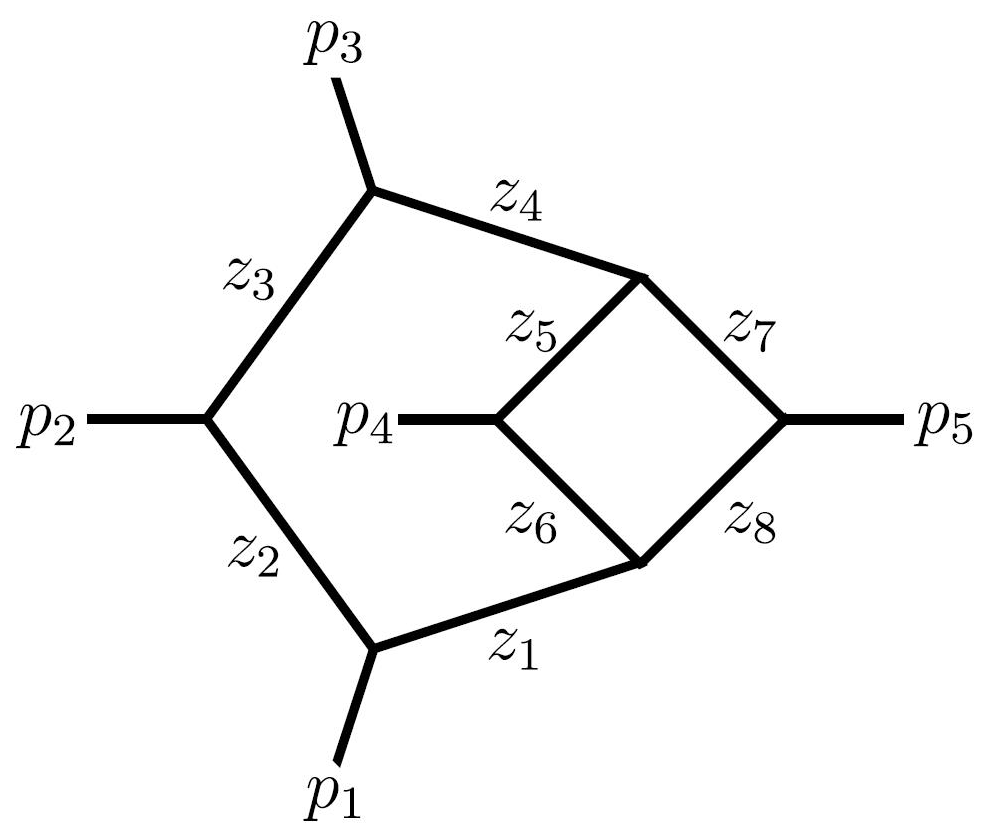 In the paper arxiv.org/abs/1805.01873 (Journal
of High Energy Physics 09 (2018) 24, 30 pp)
we
present the powerful module-intersection integration-by-parts (IBP)
method, suitable for multi-loop and multi-scale Feynman integral
reduction. Utilizing modern computational algebraic geometry techniques,
this new method successfully trims traditional IBP systems dramatically
to much simpler integral-relation systems on unitarity cuts. We
demonstrate the power of this method by explicitly carrying out the
complete analytic reduction of two-loop five-point non-planar
hexagon-box integrals, with degree-four numerators, to a basis of 73 master integrals.
In the paper arxiv.org/abs/1805.01873 (Journal
of High Energy Physics 09 (2018) 24, 30 pp)
we
present the powerful module-intersection integration-by-parts (IBP)
method, suitable for multi-loop and multi-scale Feynman integral
reduction. Utilizing modern computational algebraic geometry techniques,
this new method successfully trims traditional IBP systems dramatically
to much simpler integral-relation systems on unitarity cuts. We
demonstrate the power of this method by explicitly carrying out the
complete analytic reduction of two-loop five-point non-planar
hexagon-box integrals, with degree-four numerators, to a basis of 73 master integrals.
This paper is joint work with Alessandro Georgoudis, Kasper J. Larsen,
Hans
Schönemann,
and
Yang Zhang.
|
|
|
|
|
Computeralgebra – vom Vorlesungsthema
zum Forschungsthema
|
|
|
|
|
|
|
|
|
Complete sets of logarithmic vector
fields for integration-by-parts identities of Feynman integrals
|
|
|
|
|
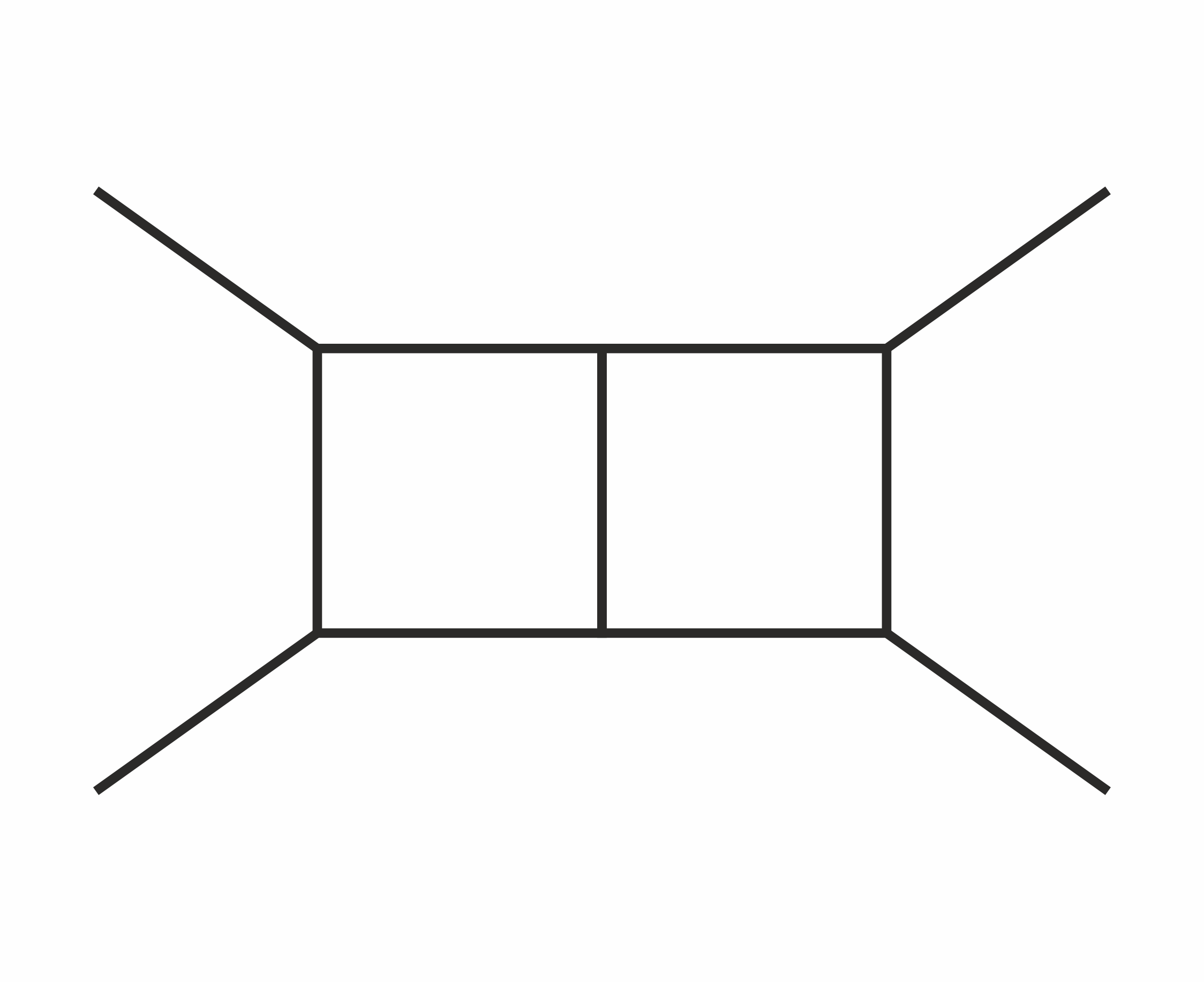 Integration-by-parts identities between loop integrals arise from the
vanishing integration of total derivatives in dimensional regularization.
Generic choices of total derivatives in the Baikov or parametric
representations lead to identities which involve dimension shifts. These
dimension shifts can be avoided by imposing a certain constraint on the total
derivatives. The solutions of this constraint turn out to be a specific type of
syzygies which correspond to logarithmic vector fields along the Gram
determinant formed of the independent external and loop momenta. In the paper arxiv.org/abs/1712.09737 (Phys. Rev. D 98,
2018, 025023)
we present an
explicit generating set of solutions in Baikov representation, valid for any
number of loops and external momenta, obtained from the Laplace expansion of
the Gram determinant. We provide a rigorous mathematical proof that this set of
solutions is complete. This proof relates the logarithmic vector fields in
question to ideals of submaximal minors of the Gram matrix and makes use of
classical resolutions of such ideals.
Integration-by-parts identities between loop integrals arise from the
vanishing integration of total derivatives in dimensional regularization.
Generic choices of total derivatives in the Baikov or parametric
representations lead to identities which involve dimension shifts. These
dimension shifts can be avoided by imposing a certain constraint on the total
derivatives. The solutions of this constraint turn out to be a specific type of
syzygies which correspond to logarithmic vector fields along the Gram
determinant formed of the independent external and loop momenta. In the paper arxiv.org/abs/1712.09737 (Phys. Rev. D 98,
2018, 025023)
we present an
explicit generating set of solutions in Baikov representation, valid for any
number of loops and external momenta, obtained from the Laplace expansion of
the Gram determinant. We provide a rigorous mathematical proof that this set of
solutions is complete. This proof relates the logarithmic vector fields in
question to ideals of submaximal minors of the Gram matrix and makes use of
classical resolutions of such ideals.
This paper is joint work with Alessandro Georgoudis,
Kasper J. Larsen,
Mathias
Schulze,
Yang Zhang.
|
|
|
|
|
Bad Primes in Computational Algebraic
Geometry
|
|
|
|
|
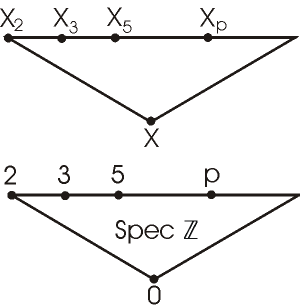 Computations over the rational numbers often suffer from intermediate coefficient
swell. One solution to this problem is to apply the
given algorithm modulo a number of primes and then lift
the modular results to the rationals. This method is
guaranteed to work if we use a sufficiently large set
of good primes. In many applications, however, there
is no efficient way of excluding bad primes. In the
paper arxiv.org/abs/1702.06920 for ICMS
2016 (Lecture
Notes in Computer Science 9725 (2016), 93-102), we illustrate a
technique for rational reconstruction which will nevertheless
return the correct result, provided the number of good
primes in the selected set of primes is large enough.
We give a number of explicit examples which are
implemented using the computer algebra system Singular and
the programming language Julia. We discuss applications
of our technique in computational algebraic geometry.
Computations over the rational numbers often suffer from intermediate coefficient
swell. One solution to this problem is to apply the
given algorithm modulo a number of primes and then lift
the modular results to the rationals. This method is
guaranteed to work if we use a sufficiently large set
of good primes. In many applications, however, there
is no efficient way of excluding bad primes. In the
paper arxiv.org/abs/1702.06920 for ICMS
2016 (Lecture
Notes in Computer Science 9725 (2016), 93-102), we illustrate a
technique for rational reconstruction which will nevertheless
return the correct result, provided the number of good
primes in the selected set of primes is large enough.
We give a number of explicit examples which are
implemented using the computer algebra system Singular and
the programming language Julia. We discuss applications
of our technique in computational algebraic geometry.
This paper is joint work with Wolfram
Decker, Claus
Fieker, Santiago
Laplagne and Gerhard
Pfister.
|
|
|
|
|
A Classification Algorithm for
Complex Singularities of Corank and Modality up to Two
|
|
|
|
|
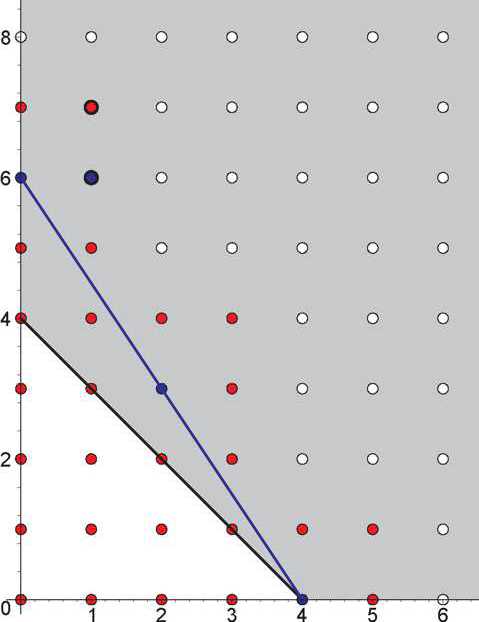 V.I. Arnold has described normal forms and has developed a classifier for,
in particular, all isolated hypersurface singularities
over the complex numbers up to modality 2. Building
on a series of 105 theorems, this classifier determines
the type of the given singularity. However, for positive
modality, this does not fix the right equivalence class
of the singularity, since the values of the moduli parameters
are not specified. In the paper arxiv.org/abs/1604.04774
(Singularities and Computer Algebra
- Festschrift for Gert-Martin Greuel on the Occasion of his 70th Birthday,
Springer 2017, 21-46),
we present a simple classification algorithm for isolated
hypersurface singularities of corank and modality up
to two. For a singularity given by a polynomial
over the rationals, the algorithm determines its right
equivalence class by specifying a polynomial representative
in Arnold's list of normal forms. We have implemented our algorithm in the library
classify2.lib for the computer algebra system Singular.
V.I. Arnold has described normal forms and has developed a classifier for,
in particular, all isolated hypersurface singularities
over the complex numbers up to modality 2. Building
on a series of 105 theorems, this classifier determines
the type of the given singularity. However, for positive
modality, this does not fix the right equivalence class
of the singularity, since the values of the moduli parameters
are not specified. In the paper arxiv.org/abs/1604.04774
(Singularities and Computer Algebra
- Festschrift for Gert-Martin Greuel on the Occasion of his 70th Birthday,
Springer 2017, 21-46),
we present a simple classification algorithm for isolated
hypersurface singularities of corank and modality up
to two. For a singularity given by a polynomial
over the rationals, the algorithm determines its right
equivalence class by specifying a polynomial representative
in Arnold's list of normal forms. We have implemented our algorithm in the library
classify2.lib for the computer algebra system Singular.
This paper is joint work with Magdaleen
Marais and
Gerhard
Pfister.
|
|
|
|
|
Computing GIT-Fans with Symmetry and the Mori Chamber Decomposition of
M0,6 |
|
|
|
|
 In the paper arxiv.org/abs/1603.09241 (Mathematics
of
Computation (2020)) we
present an algorithm to compute the GIT-fan for torus actions on affine varieties with symmetries. The algorithm
combines computational techniques from commutative algebra, convex geometry and group
theory. We have implemented our algorithm in the library
gitfan.lib for the computer algebra system Singular. Using our implementation, we compute the Mori chamber
decomposition of the cone of movable divisors of
the
Deligne-Mumford moduli space of 6-pointed stable curves
of genus 0. The resulting GIT-fan data can be read
out from a list of hashes representing cones through
the library M06chambers.lib.
In the paper arxiv.org/abs/1603.09241 (Mathematics
of
Computation (2020)) we
present an algorithm to compute the GIT-fan for torus actions on affine varieties with symmetries. The algorithm
combines computational techniques from commutative algebra, convex geometry and group
theory. We have implemented our algorithm in the library
gitfan.lib for the computer algebra system Singular. Using our implementation, we compute the Mori chamber
decomposition of the cone of movable divisors of
the
Deligne-Mumford moduli space of 6-pointed stable curves
of genus 0. The resulting GIT-fan data can be read
out from a list of hashes representing cones through
the library M06chambers.lib.
This paper is joint work with Simon Keicher and
Yue Ren.
|
|
|
|
|
A smoothness test for higher codimensions |
|
|
|
|
 Based on an idea in Hironaka's proof of resolution of singularities, we present in arxiv.org/abs/1602.04522
(J.
Symb. Comp. 86 (2017), 153-165) an algorithmic smoothness test for algebraic varieties. The test is
inherently parallel and does not involve the calculation of codimension-sized
minors of the Jacobian matrix of the variety. We also describe a hybrid method
which combines the new method with the Jacobian criterion, thus making use of
the strengths of both approaches. We have implemented all algorithms in the
library smoothtst.lib for the
computer algebra system Singular, and compare the different approaches with
respect to timings and memory usage. The test examples originate from questions
in algebraic geometry, where the use of the Jacobian criterion is impractical
due to the number and size of the minors involved.
Based on an idea in Hironaka's proof of resolution of singularities, we present in arxiv.org/abs/1602.04522
(J.
Symb. Comp. 86 (2017), 153-165) an algorithmic smoothness test for algebraic varieties. The test is
inherently parallel and does not involve the calculation of codimension-sized
minors of the Jacobian matrix of the variety. We also describe a hybrid method
which combines the new method with the Jacobian criterion, thus making use of
the strengths of both approaches. We have implemented all algorithms in the
library smoothtst.lib for the
computer algebra system Singular, and compare the different approaches with
respect to timings and memory usage. The test examples originate from questions
in algebraic geometry, where the use of the Jacobian criterion is impractical
due to the number and size of the minors involved.
This paper is joint work with Anne
Frühbis-Krüger.
|
|
|
|
|
Current Challenges in Developing
Open Source Computer Algebra Systems
|
|
|
|
|
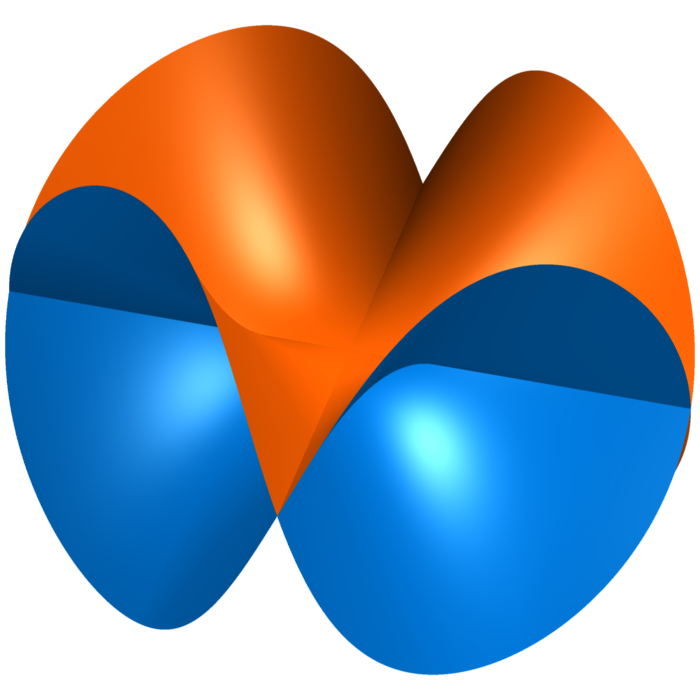 In the paper arxiv.org/abs/1702.06912 for the Sixth International Conference on Mathematical Aspects
of Computer and Information Sciences MACIS
2015 (Lecture
Notes in Computer Science 9582 (2016), 3-24) we discuss current challenges in developing
Open Source computer algebra systems. The main focus
is on algebraic geometry and the system Singular.
Taking this point of view, we first address the efficiency of basic algorithms,
parallelization, making abstract concepts of algebraic
geometry constructive, the interaction of computer
algebra systems and libraries, creating and integrating
mathematical databases, and facilitating
access to computer algebra systems. We then focus on
two main topics: At the example of normalization, we discuss
how to turn a sequential algorithm into a parallel algorithm.
Considering the computation of GIT-fans with
symmetry, we illustrate an algorithm that uses Gröbner
bases, polyhedral computations and algorithmic group
theory. This note is based on the plenary talk
given by the second author, and is motivated by some
of the work done within the Priority Programme SPP 1489
of the German Research Council DFG.
In the paper arxiv.org/abs/1702.06912 for the Sixth International Conference on Mathematical Aspects
of Computer and Information Sciences MACIS
2015 (Lecture
Notes in Computer Science 9582 (2016), 3-24) we discuss current challenges in developing
Open Source computer algebra systems. The main focus
is on algebraic geometry and the system Singular.
Taking this point of view, we first address the efficiency of basic algorithms,
parallelization, making abstract concepts of algebraic
geometry constructive, the interaction of computer
algebra systems and libraries, creating and integrating
mathematical databases, and facilitating
access to computer algebra systems. We then focus on
two main topics: At the example of normalization, we discuss
how to turn a sequential algorithm into a parallel algorithm.
Considering the computation of GIT-fans with
symmetry, we illustrate an algorithm that uses Gröbner
bases, polyhedral computations and algorithmic group
theory. This note is based on the plenary talk
given by the second author, and is motivated by some
of the work done within the Priority Programme SPP 1489
of the German Research Council DFG.
This paper is joint work with Wolfram
Decker, Simon Keicher, and
Yue Ren.
|
|
|
|
|
|
The Classification of Real
Singularities Using Singular. Part III:
Unimodal Singularities
of Corank 2
|
|
|
|
|
 In arxiv.org/abs/1512.09028 (J.
Symb. Comp. 99 (2020), 250-282) we
present a classification algorithm for isolated hypersurface singularities
of corank 2 and modality 1 over the real numbers. For a singularity given by a
polynomial over the rationals, the algorithm determines its right equivalence
class by specifying all representatives in Arnold's list of normal forms
(Arnold et al. 1985) belonging to this class, and the corresponding values of
the moduli parameter. We discuss how to computationally realize the individual
steps of the algorithm for all singularities in consideration, and give
explicit examples. The algorithm is implemented in the Singular library
realclassify.lib.
In arxiv.org/abs/1512.09028 (J.
Symb. Comp. 99 (2020), 250-282) we
present a classification algorithm for isolated hypersurface singularities
of corank 2 and modality 1 over the real numbers. For a singularity given by a
polynomial over the rationals, the algorithm determines its right equivalence
class by specifying all representatives in Arnold's list of normal forms
(Arnold et al. 1985) belonging to this class, and the corresponding values of
the moduli parameter. We discuss how to computationally realize the individual
steps of the algorithm for all singularities in consideration, and give
explicit examples. The algorithm is implemented in the Singular library
realclassify.lib.
The paper is joint work with Magdaleen
Marais and Andreas Steenpaß.
|
|
|
|
|
Computing integral bases via localization and Hensel lifting
|
|
|
|
|
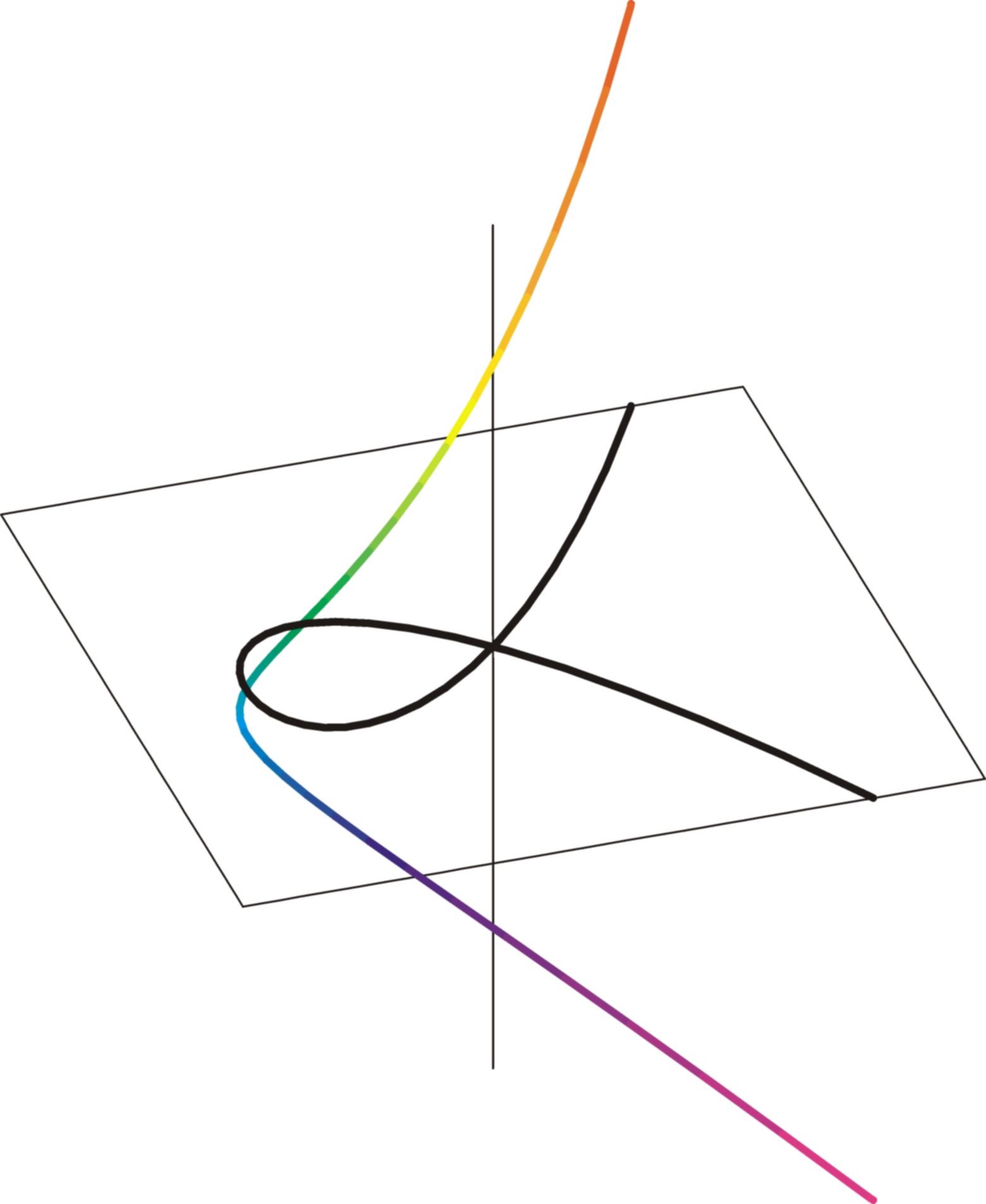 In arxiv.org/abs/1505.05054
(J.
Symb. Comp. (2020)) we present a new algorithm for computing integral bases in algebraic function
fields, or equivalently for constructing the normalization of a plane curve.
Our basic strategy makes use of localization and, then, completion at each
singularity of the curve. In this way, we are reduced to finding integral bases
at the branches of the singularities. To solve the latter task, we work with
suitably truncated Puiseux expansions. In contrast to van Hoeij's algorithm,
which also relies on Puiseux expansions (but pursues a different strategy), we
use Hensel's lemma as a key ingredient. This allows us to compute factors
corresponding to groups of conjugate Puiseux expansions, without actually
computing the individual expansions. In this way, we make substantially less
use of the Newton-Puiseux algorithm. In addition, our algorithm is inherently
parallel. As a result, it outperforms in most cases any other algorithm known
to us by far. Typical applications are the computation of adjoint ideals and,
based on this, the computation of Riemann-Roch spaces and the parametrization
of rational curves. In arxiv.org/abs/1505.05054
(J.
Symb. Comp. (2020)) we present a new algorithm for computing integral bases in algebraic function
fields, or equivalently for constructing the normalization of a plane curve.
Our basic strategy makes use of localization and, then, completion at each
singularity of the curve. In this way, we are reduced to finding integral bases
at the branches of the singularities. To solve the latter task, we work with
suitably truncated Puiseux expansions. In contrast to van Hoeij's algorithm,
which also relies on Puiseux expansions (but pursues a different strategy), we
use Hensel's lemma as a key ingredient. This allows us to compute factors
corresponding to groups of conjugate Puiseux expansions, without actually
computing the individual expansions. In this way, we make substantially less
use of the Newton-Puiseux algorithm. In addition, our algorithm is inherently
parallel. As a result, it outperforms in most cases any other algorithm known
to us by far. Typical applications are the computation of adjoint ideals and,
based on this, the computation of Riemann-Roch spaces and the parametrization
of rational curves.
The paper is joint work with Wolfram
Decker, Santiago
Laplagne and Gerhard
Pfister.
|
|
|
|
|
Local to global algorithms for the Gorenstein adjoint ideal of a curve
|
|
|
|
|
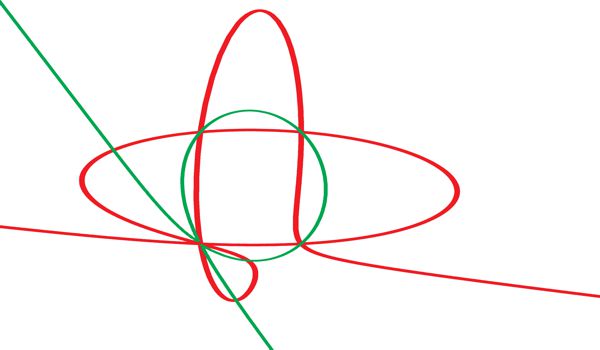 In arxiv.org/abs/1505.05040 (in
Algorithmic and Experimental Methods in Algebra, Geometry, and Number Theory,
Springer 2017) we present new algorithms for computing adjoint ideals of curves and thus, in
the planar case, adjoint curves. With regard to terminology, we follow
Gorenstein who states the adjoint condition in terms of conductors. Our main
algorithm yields the Gorenstein adjoint ideal G of a given curve as the
intersection of what we call local Gorenstein adjoint ideals. Since the
respective local computations do not depend on each other, our approach is
inherently parallel. Over the rationals, further parallelization is achieved by
a modular version of the algorithm which first computes a number of the
characteristic p counterparts of G and then lifts these to characteristic zero.
As a key ingredient, we establish an efficient criterion to verify the
correctness of the lift. Well-known applications are the computation of
Riemann-Roch spaces, the construction of points in moduli spaces, and the
parametrization of rational curves. We have implemented different variants of
our algorithms together with Mnuk's approach in the computer algebra system
Singular and give timings to compare the performance of the algorithms. In arxiv.org/abs/1505.05040 (in
Algorithmic and Experimental Methods in Algebra, Geometry, and Number Theory,
Springer 2017) we present new algorithms for computing adjoint ideals of curves and thus, in
the planar case, adjoint curves. With regard to terminology, we follow
Gorenstein who states the adjoint condition in terms of conductors. Our main
algorithm yields the Gorenstein adjoint ideal G of a given curve as the
intersection of what we call local Gorenstein adjoint ideals. Since the
respective local computations do not depend on each other, our approach is
inherently parallel. Over the rationals, further parallelization is achieved by
a modular version of the algorithm which first computes a number of the
characteristic p counterparts of G and then lifts these to characteristic zero.
As a key ingredient, we establish an efficient criterion to verify the
correctness of the lift. Well-known applications are the computation of
Riemann-Roch spaces, the construction of points in moduli spaces, and the
parametrization of rational curves. We have implemented different variants of
our algorithms together with Mnuk's approach in the computer algebra system
Singular and give timings to compare the performance of the algorithms.
The paper is joint work with Wolfram
Decker, Santiago
Laplagne and Gerhard
Pfister.
|
|
|
|
|
Weak Lefschetz Property and Stellar Subdivisions of Gorenstein Complexes
|
|
|
|
|
An important open question in algebraic
combinatorics is whether for a simplicial sphere, or
more generally for a Gorenstein* simplicial complex,
the f-vector satisfies McMullen's g-conjecture. Assume σ is a face of a Gorenstein* simplicial complex D. For
the g-conjecture to hold it is enough to prove that
the Stanley-Reisner ring of D over the real numbers
satisfies the Weak Lefschetz Property.
In arxiv.org/abs/1501.01513
(Australas. J. Combin.
76 (2020), 266-287) we
investigate
the question of whether the Weak Lefschetz Property of the Stanley-Reisner ring
k[D] (over an infinite field k) is equivalent to the same property of the
Stanley-Reisner ring k[Dσ] of the stellar subdivision Dσ
of D at σ. We prove
that this is the case if 2(dim σ) > dim(D)+1.
If this equivalence was to be proven without any assumptions on the dimension
of σ, it would then have as a corollary the g-conjecture
for the class of PL-spheres. In the last section we give
some further results and constructions which could,
perhaps, prove useful in attacking the problem in general.
The paper is joint work with Stavros Papadakis.
|
|
|
|
|
3D Printing Dimensional Calibration
Shape: Clebsch Cubic
|
|
|
|
|
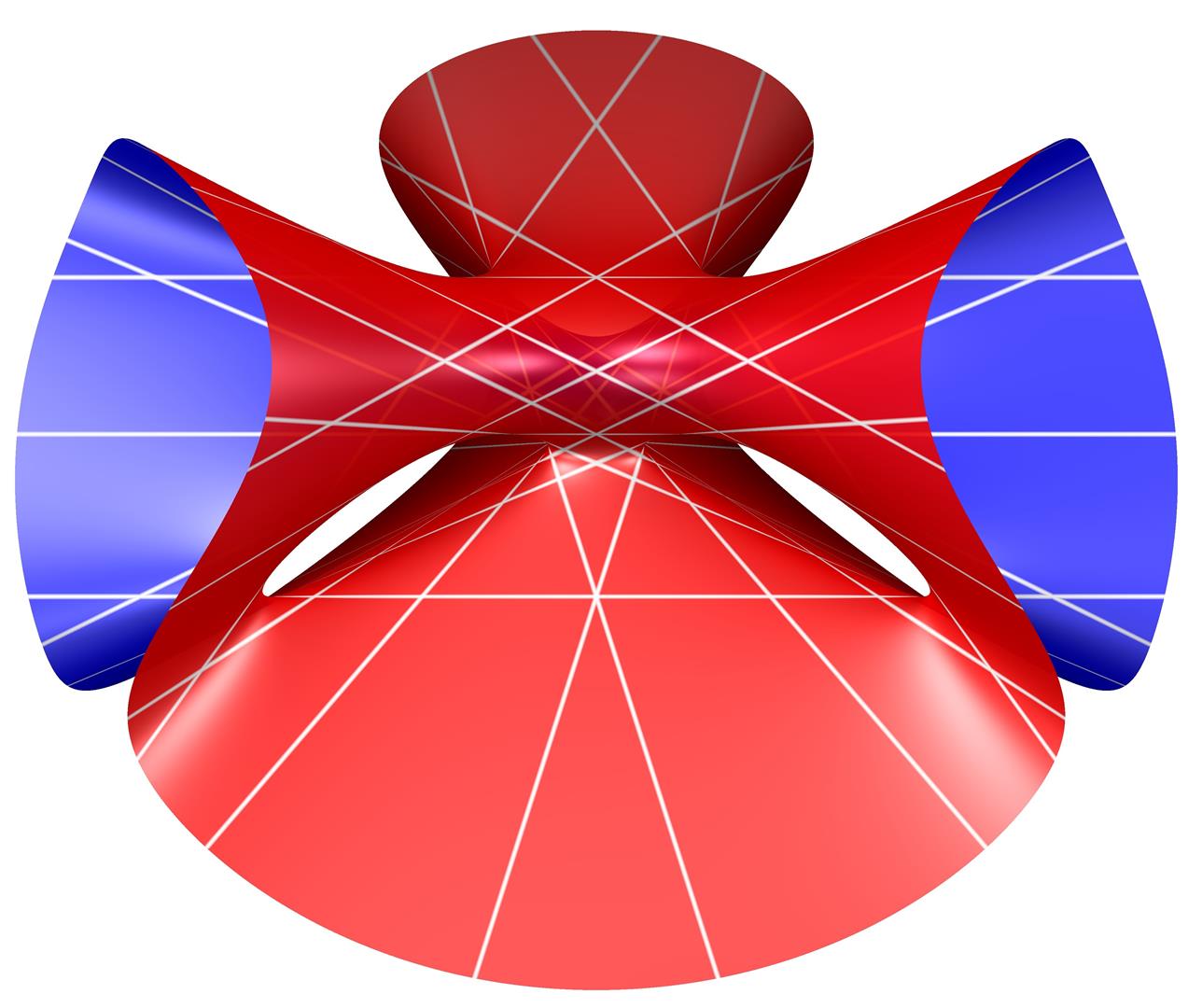 3D
printing and other layer manufacturing processes are
challenged by dimensional accuracy. In http://arxiv.org/abs/1512.09036 (ICMS
2016, Lecture
Notes in Computer Science 9725 (2016), 117-126) we
propose to use objects from algebraic geometry as test
shapes. Processes with the risk of deformation after
time or post processing may find this technique beneficial.
A cubic surface is given as the zero set of a 3rd degree
polynomial with 3 variables. A class of cubics in real
3D space contains exactly 27 real lines. We provide
a library for the computer algebra system Singular which,
from 6 given points in the plane, constructs a cubic
and the lines on it. The cubic offers simplicity to
the dimensional comparison process, in that the lines
and many other features can be analytically determined
and easily measured. For example, the surface contains
so-called Eckhard points, in each of which three of
the lines intersect. At all intersection points of lines,
angles can be verified. Hence, many features distributed
over the build volume are known analytically, and can
be used for the validation process. Due to the thin
shape geometry the material required to produce an algebraic
surface is minimal. 3D
printing and other layer manufacturing processes are
challenged by dimensional accuracy. In http://arxiv.org/abs/1512.09036 (ICMS
2016, Lecture
Notes in Computer Science 9725 (2016), 117-126) we
propose to use objects from algebraic geometry as test
shapes. Processes with the risk of deformation after
time or post processing may find this technique beneficial.
A cubic surface is given as the zero set of a 3rd degree
polynomial with 3 variables. A class of cubics in real
3D space contains exactly 27 real lines. We provide
a library for the computer algebra system Singular which,
from 6 given points in the plane, constructs a cubic
and the lines on it. The cubic offers simplicity to
the dimensional comparison process, in that the lines
and many other features can be analytically determined
and easily measured. For example, the surface contains
so-called Eckhard points, in each of which three of
the lines intersect. At all intersection points of lines,
angles can be verified. Hence, many features distributed
over the build volume are known analytically, and can
be used for the validation process. Due to the thin
shape geometry the material required to produce an algebraic
surface is minimal.
The paper is joint work with Magdaleen
Marais and Andre
van der Merwe.
|
|
|
|
|
Tropical mirror symmetry for elliptic curves
|
|
|
|
|
 Mirror symmetry relates Gromov-Witten invariants of an elliptic curve with
certain integrals over Feynman graphs. In arxiv.org/abs/1309.5893
(J.
Reine Angew. Math. (Crelles Journal), Vol. 2017, Issue 732, 211–246
DOI: 10.1515/crelle-2014-0143) we
prove a tropical generalization of
mirror symmetry for elliptic curves, i.e., a statement relating certain labeled
Gromov-Witten invariants of a tropical elliptic curve to more refined Feynman
integrals. This result easily implies the tropical analogue of the mirror
symmetry statement mentioned above and, using the necessary Correspondence
Theorem, also the mirror symmetry statement itself. In this way, our tropical
generalization leads to an alternative proof of mirror symmetry for elliptic
curves. We believe that our approach via tropical mirror symmetry naturally
carries the potential of being generalized to more adventurous situations of
mirror symmetry. Moreover, our tropical approach has the advantage that all
involved invariants are easy to compute. Furthermore, we can use the techniques
for computing Feynman integrals to prove that they are quasimodular forms.
Also, as a side product, we can give a combinatorial characterization of
Feynman graphs for which the corresponding integrals are zero. More generally,
the tropical mirror symmetry theorem gives a natural interpretation of the
A-model side (i.e., the generating function of Gromov-Witten invariants) in
terms of a sum over Feynman graphs. Hence our quasimodularity result becomes
meaningful on the A-model side as well. Our theoretical results are
complemented by a Singular package including several procedures that can be
used to compute Hurwitz numbers of the elliptic curve as integrals over Feynman
graphs. Mirror symmetry relates Gromov-Witten invariants of an elliptic curve with
certain integrals over Feynman graphs. In arxiv.org/abs/1309.5893
(J.
Reine Angew. Math. (Crelles Journal), Vol. 2017, Issue 732, 211–246
DOI: 10.1515/crelle-2014-0143) we
prove a tropical generalization of
mirror symmetry for elliptic curves, i.e., a statement relating certain labeled
Gromov-Witten invariants of a tropical elliptic curve to more refined Feynman
integrals. This result easily implies the tropical analogue of the mirror
symmetry statement mentioned above and, using the necessary Correspondence
Theorem, also the mirror symmetry statement itself. In this way, our tropical
generalization leads to an alternative proof of mirror symmetry for elliptic
curves. We believe that our approach via tropical mirror symmetry naturally
carries the potential of being generalized to more adventurous situations of
mirror symmetry. Moreover, our tropical approach has the advantage that all
involved invariants are easy to compute. Furthermore, we can use the techniques
for computing Feynman integrals to prove that they are quasimodular forms.
Also, as a side product, we can give a combinatorial characterization of
Feynman graphs for which the corresponding integrals are zero. More generally,
the tropical mirror symmetry theorem gives a natural interpretation of the
A-model side (i.e., the generating function of Gromov-Witten invariants) in
terms of a sum over Feynman graphs. Hence our quasimodularity result becomes
meaningful on the A-model side as well. Our theoretical results are
complemented by a Singular package including several procedures that can be
used to compute Hurwitz numbers of the elliptic curve as integrals over Feynman
graphs.
The paper is joint work with Kathrin
Bringmann, Arne
Buchholz and Hannah
Markwig.
|
|
|
|
|
Local analysis of Grauert-Remmert-type normalization algorithms
|
|
|
|
|
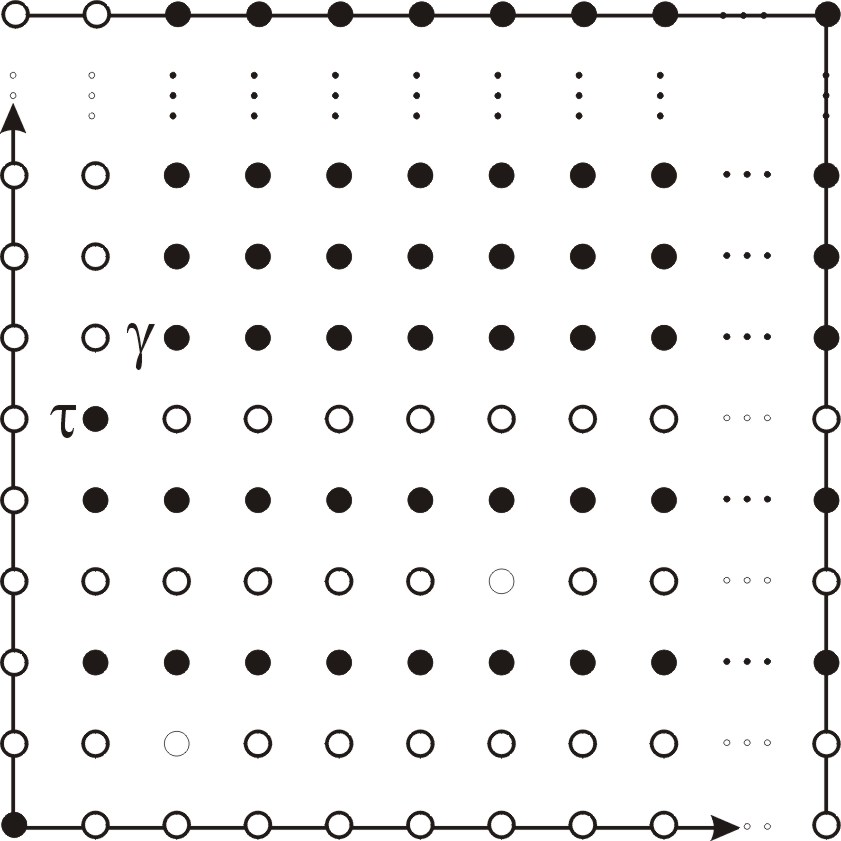 Normalization is a fundamental ring-theoretic operation; geometrically it
resolves singularities in codimension one. Existing algorithmic methods for
computing the normalization rely on a common recipe: successively enlarge the
given ring in form an endomorphism ring of a certain (fractional) ideal until
the process becomes stationary. While Vasconcelos' method uses the dual
Jacobian ideal, Grauert-Remmert-type algorithms rely on so-called test ideals. Normalization is a fundamental ring-theoretic operation; geometrically it
resolves singularities in codimension one. Existing algorithmic methods for
computing the normalization rely on a common recipe: successively enlarge the
given ring in form an endomorphism ring of a certain (fractional) ideal until
the process becomes stationary. While Vasconcelos' method uses the dual
Jacobian ideal, Grauert-Remmert-type algorithms rely on so-called test ideals.
For algebraic varieties, one can apply such normalization algorithms
globally, locally, or formal analytically at all points of the variety. In http://arxiv.org/abs/1309.4620
(IJAC
24, No. 1 (2014), 69-94), we relate the number of iterations for global Grauert-Remmert-type
normalization algorithms to that of its local descendants.
We complement our results by an explicit study of ADE singularities. This
includes the description of the normalization process in terms of value
semigroups of curves. The intermediate steps produce ADE
singularities and simple space curve singularities from the list of
Fruehbis-Krueger.
The paper is joint work with Wolfram
Decker and Mathias
Schulze.
|
|
|
|
|
Bounds for the Betti numbers of successive stellar
subdivisions of a simplex
|
|
|
|
|
 In
http://arxiv.org/abs/1212.4358 (Hokkaido
Math. J. 44 (2015), 341-364) we
give a bound for the Betti numbers of the Stanley-Reisner
ring of a stellar subdivision of a Gorenstein* simplicial
complex by applying unprojection theory. From this we
derive a bound for the Betti numbers of iterated stellar
subdivisions of the boundary complex of a simplex. The
bound depends only on the number of subdivisions, and
we construct examples which prove that it is sharp (for
an implementation of the construction see BettiBounds.m2). In
http://arxiv.org/abs/1212.4358 (Hokkaido
Math. J. 44 (2015), 341-364) we
give a bound for the Betti numbers of the Stanley-Reisner
ring of a stellar subdivision of a Gorenstein* simplicial
complex by applying unprojection theory. From this we
derive a bound for the Betti numbers of iterated stellar
subdivisions of the boundary complex of a simplex. The
bound depends only on the number of subdivisions, and
we construct examples which prove that it is sharp (for
an implementation of the construction see BettiBounds.m2).
The paper and package are joint work with Stavros Papadakis.
|
|
|
|
|
The use of bad primes in rational reconstruction
|
|
|
|
|
 A standard method for computing a
rational number from its values modulo a collection
of primes is to determine its value modulo the product
of the primes via Chinese Remaindering, and then use
Farey sequences for rational reconstruction. Successively
enlarging the set of primes if needed, this method is
guaranteed to work if we restrict ourselves to "good"
primes. Depending on the particular application, however,
there is often no efficient way of finding good primes.
This note shows that in most situations, we can simply
ignore this problem. In fact, we present an error tolerant
algorithm for rational reconstruction. With regard to
applications, we are particularly interested in the
design of modular and, thus, parallel versions of algorithms
in commutative algebra and algebraic geometry. Here,
typically, the final result consists of one or several
a priori unknown ideals which are found via constructions
yielding the (reduced) Groebner bases of the ideals. A standard method for computing a
rational number from its values modulo a collection
of primes is to determine its value modulo the product
of the primes via Chinese Remaindering, and then use
Farey sequences for rational reconstruction. Successively
enlarging the set of primes if needed, this method is
guaranteed to work if we restrict ourselves to "good"
primes. Depending on the particular application, however,
there is often no efficient way of finding good primes.
This note shows that in most situations, we can simply
ignore this problem. In fact, we present an error tolerant
algorithm for rational reconstruction. With regard to
applications, we are particularly interested in the
design of modular and, thus, parallel versions of algorithms
in commutative algebra and algebraic geometry. Here,
typically, the final result consists of one or several
a priori unknown ideals which are found via constructions
yielding the (reduced) Groebner bases of the ideals.
The paper http://arxiv.org/abs/1207.1651 (Mathematics
of
Computation 84 (2015), 3013-3027) is joint work with Wolfram
Decker, Claus
Fieker and Gerhard
Pfister.
|
|
|
|
|
Decomposition of Monomial Algebras: Applications
and Algorithms
|
|
|
|
|
Considering finite extensions of positive
affine semigroup rings K[B] of K[A] over a field
K we have developed in [BEN]
an algorithm to decompose K[B] as a direct sum of monomial
ideals in K[A]. By computing the regularity of homogeneous
semigroup rings from the decomposition we have confirmed
the Eisenbud-Goto conjecture in a range of new cases
not tractable by standard methods. Here we first illustrate
this technique and its implementation in our Macaulay2
package MonomialAlgebras by computing the decomposition
and the regularity step by step for an explicit example.
We then focus on ring-theoretic properties of simplicial
semigroup rings. From the characterizations given in
[BEN] we
develop and prove explicit algorithms testing properties
like Buchsbaum, Cohen-Macaulay, Gorenstein, normal,
and seminormal, all of which imply the Eisenbud-Goto
conjecture. All algorithms are implemented in our Macaulay2
package.
The paper http://arxiv.org/abs/1206.1735 (JSAG 5 (2013), 8-14) and the
package for
Macaulay2 are joint work with David
Eisenbud and Max Nitsche.
|
|
|
|
|
Parallel algorithms for normalization
|
|
|
|
|
Given a reduced affine algebra A over a perfect field K, we present parallel
algorithms to compute the normalization A of A. Our starting point is the
algorithm of Greuel, Laplagne, and Seelisch, which is an improvement of de
Jong's algorithm. First, we propose to stratify the singular locus Sing(A) in a
way which is compatible with normalization, apply a local version of the
normalization algorithm at each stratum, and find A by putting the local
results together. Second, in the case where K = Q is the field of rationals, we
propose modular versions of the global and local algorithms. We have
implemented our algorithms in the computer algebra system Singular and compare
their performance with that of other algorithms. In the case where K = Q, we
also discuss the use of modular computations of Groebner bases, radicals and
primary decompositions. We point out that in most examples, the new algorithms
outperform the algorithm of Greuel, Laplagne, and Seelisch by far, even if we
do not run them in parallel.
The paper http://arxiv.org/abs/1110.4299
(J.
Symb. Comp. 51 (2013), 99-114) and the Singular packages locnormal.lib
and modnormal.lib are joint work with Wolfram
Decker, Santiago
Laplagne, Gerhard
Pfister, Andreas Steenpaß, and Stefan
Steidel.
|
|
|
|
|
Decomposition of semigroup algebras
|
|
|
|
|
 Let A contained in B be cancellative abelian semigroups, and let R be an
integral domain. We show that the semigroup ring R[B] can be decomposed, as an
R[A]-module, into a direct sum of R[A]-submodules of the quotient ring of R[A].
In the case of a finite extension of positive affine semigroup rings we obtain
an algorithm computing the decomposition. When R[A] is a polynomial ring over a
field we explain how to compute many ring-theoretic properties of R[B] in terms
of this decomposition. In particular we obtain a fast algorithm to compute the
Castelnuovo-Mumford regularity of homogeneous semigroup rings. As an
application we confirm the Eisenbud-Goto conjecture in a range of new cases.
Our algorithms are implemented in the Macaulay2 package MonomialAlgebras. Let A contained in B be cancellative abelian semigroups, and let R be an
integral domain. We show that the semigroup ring R[B] can be decomposed, as an
R[A]-module, into a direct sum of R[A]-submodules of the quotient ring of R[A].
In the case of a finite extension of positive affine semigroup rings we obtain
an algorithm computing the decomposition. When R[A] is a polynomial ring over a
field we explain how to compute many ring-theoretic properties of R[B] in terms
of this decomposition. In particular we obtain a fast algorithm to compute the
Castelnuovo-Mumford regularity of homogeneous semigroup rings. As an
application we confirm the Eisenbud-Goto conjecture in a range of new cases.
Our algorithms are implemented in the Macaulay2 package MonomialAlgebras.
The paper http://arxiv.org/abs/1110.3653 (Exper. Math.
21(4) (2012), 385-394)
and the Macaulay2 package are joint work with David
Eisenbud and Max Nitsche.
|
|
|
|
|
Implementing the Kustin-Miller complex construction
|
|
|
|
|
The Kustin-Miller complex construction,
due to A. Kustin and M. Miller, can be applied to a
pair of resolutions of Gorenstein rings with certain
properties to obtain a new Gorenstein ring and a resolution
of it. It gives a tool to construct and analyze Gorenstein
rings of high codimension. In the joint work http://arxiv.org/abs/1103.2314
(JSAG 4 (2012), 6-12) with Stavros Papadakis we
describe an algorithm computing the Kustin-Miller
complex and its implementation in the Macaulay2 package
KustinMiller. We explain how it can be applied
to explicit examples from geometry and commutative algebra.
|
|
|
|
|
On the structure of Stanley-Reisner rings associated
to cyclic polytopes
|
|
|
|
|
 In
the joint work http://arxiv.org/abs/0912.2152 (Osaka J. Math. 49-1
(2012),
81-100) with Stavros Papadakis we study the structure of Stanley-Reisner
rings associated to cyclic polytopes, using ideas from
unprojection theory. Consider the boundary simplicial
complex Δ(d;m) of the d-dimensional cyclic polytope
with m vertices. We show how to express the Stanley-Reisner
ring of Δ(d;m+1) in terms of the Stanley{Reisner rings
of Δ(d;m) and Δ(d-2;m-1). As an application, we use
the Kustin-Miller complex construction to identify the
minimal graded free resolutions of these rings. In particular,
we recover results of Schenzel, Terai and Hibi about
their graded Betti numbers. In
the joint work http://arxiv.org/abs/0912.2152 (Osaka J. Math. 49-1
(2012),
81-100) with Stavros Papadakis we study the structure of Stanley-Reisner
rings associated to cyclic polytopes, using ideas from
unprojection theory. Consider the boundary simplicial
complex Δ(d;m) of the d-dimensional cyclic polytope
with m vertices. We show how to express the Stanley-Reisner
ring of Δ(d;m+1) in terms of the Stanley{Reisner rings
of Δ(d;m) and Δ(d-2;m-1). As an application, we use
the Kustin-Miller complex construction to identify the
minimal graded free resolutions of these rings. In particular,
we recover results of Schenzel, Terai and Hibi about
their graded Betti numbers.
An implementation of this algorithm
for the computer algebra system Macaulay2
is available in the package CyclicPolytopeRes.m2,
which computes the minimal resolution of the Stanley-Reisner
ring of
Δ(d,m) using unprojection theory. It also allows the user to compute
the flat unprojection family and output the unprojection
structure of Δ(d,m).
|
|
|
|
|
Stellar subdivisions and Stanley-Reisner rings
of Gorenstein complexes
|
|
|
|
|
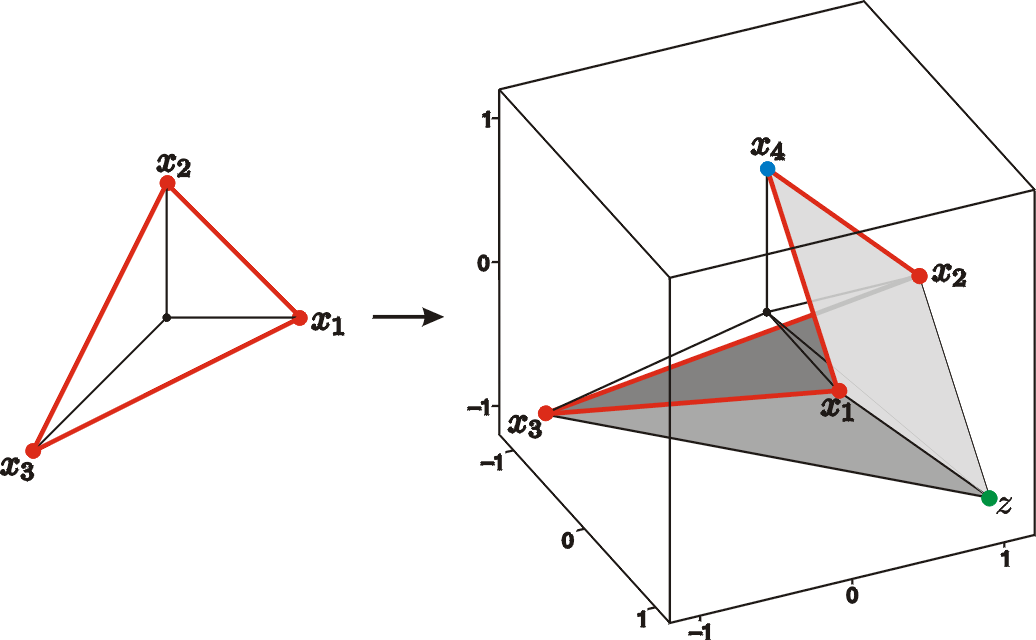 In
the joint work http://arxiv.org/abs/0912.2152
with
Stavros Papadakis
(Australas. J. Combin.
55 (2013), 235-247) we relate the theory of unprojection
(so in some sense birational geometry) to the theroy
of Stanley-Reisner rings. The aim of unprojection theory
is to analyze and construct complicated commutative
rings in terms of simpler ones. Our main result is that,
on the algebraic level of Stanley-Reisner rings, stellar
subdivisions of non-acyclic Gorenstein simplicial complexes
correspond to flat unprojection families of type
Kustin-Miller. As an application, we inductively calculate
the minimal graded free resolutions of Stanley-Reisner
rings associated to stacked polytopes. In
the joint work http://arxiv.org/abs/0912.2152
with
Stavros Papadakis
(Australas. J. Combin.
55 (2013), 235-247) we relate the theory of unprojection
(so in some sense birational geometry) to the theroy
of Stanley-Reisner rings. The aim of unprojection theory
is to analyze and construct complicated commutative
rings in terms of simpler ones. Our main result is that,
on the algebraic level of Stanley-Reisner rings, stellar
subdivisions of non-acyclic Gorenstein simplicial complexes
correspond to flat unprojection families of type
Kustin-Miller. As an application, we inductively calculate
the minimal graded free resolutions of Stanley-Reisner
rings associated to stacked polytopes.
|
|
|
|
|
A framework for tropical mirror symmetry |
|
|
|
Applying tropical geometry I proposed in http://arxiv.org/abs/0708.4402
a framework for mirror symmetry, including a
mirror construction for Calabi-Yau varieties. In http://arxiv.org/abs/1103.2673 we
discuss the conceptual foundations of this construction based on a natural
mirror map identifying deformations and divisors. We show how the construction
specializes to that by Batyrev for hypersurfaces and its generalization by
Batyrev and Borisov to complete intersections. Based on an explicit example we
comment on the implementation in the Macaulay2 package SRdeformations:
|
|
|
|
|
SRdeformations.m2
|
|
|
|
| 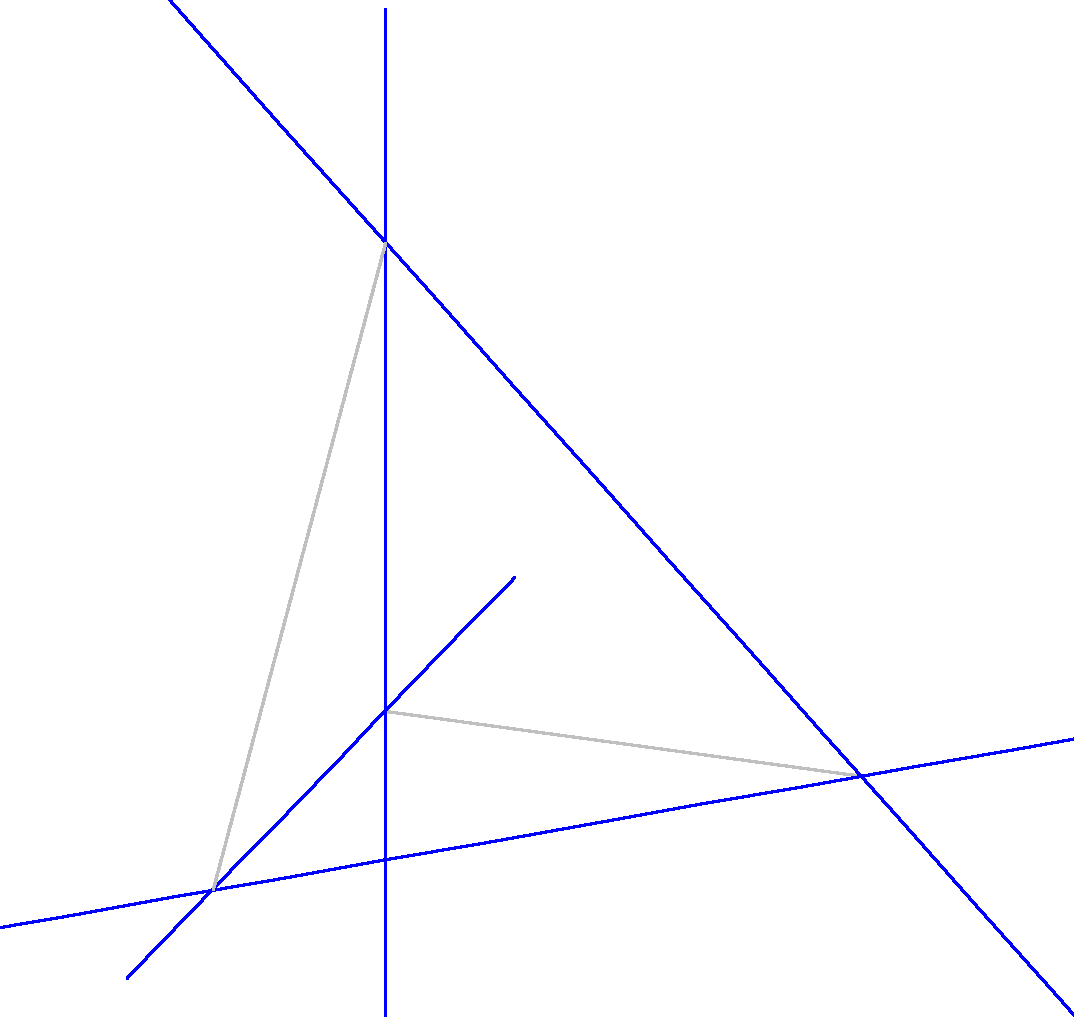 This
is
an extensive project in progress to provide in the computer
algebra system Macaulay2 a
computational framework for tropical mirror symmetry
and as part of this also deformations of Stanley-Reisner
rings. It has efficient data types to store and dualize tropical
varieties, polytopes and faces thereof. This
is
an extensive project in progress to provide in the computer
algebra system Macaulay2 a
computational framework for tropical mirror symmetry
and as part of this also deformations of Stanley-Reisner
rings. It has efficient data types to store and dualize tropical
varieties, polytopes and faces thereof.
You can find
the latest stable version of this package also
in the Macaulay2 distribution.
This package can use (for
performance reasons) the packages ConvexInterface.m2
and MapleInterface.m2.
You can also find the latest stable version of
this package in the Macaulay2 distribution. I also have a Singular
project going on about this topic.
|
|
|
|
|
Mirror symmetry and tropical geometry
|
|
|
|
| 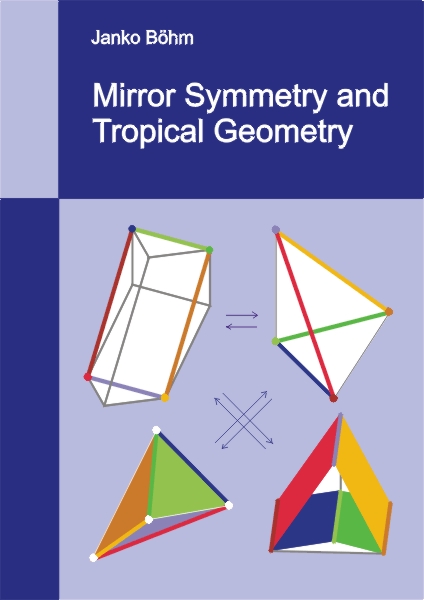 Via
tropical geometry, toric geometry, Gröbner bases and
deformation theory a general framework for mirror
symmetry of Calabi-Yau varieties leading to an
algorithmic mirror construction is developed in
my PhD thesis. The tropical mirror
construction comes with a natural mirror map identifying
deformations and divisors. It reproduces the construction
by Batyrev for hypersurfaces, the generalization
thereof by Batyrev and Borisov to complete
intersections and a construction by Roedland
for a particular non-complete intersection Pfaffian Calabi-Yau 3-fold.
We also obtain a new mirror by applying the construction
to the non-complete intersection Pfaffian
Calabi-Yau 3-fold of degree 13 in projective 6-space. Via
tropical geometry, toric geometry, Gröbner bases and
deformation theory a general framework for mirror
symmetry of Calabi-Yau varieties leading to an
algorithmic mirror construction is developed in
my PhD thesis. The tropical mirror
construction comes with a natural mirror map identifying
deformations and divisors. It reproduces the construction
by Batyrev for hypersurfaces, the generalization
thereof by Batyrev and Borisov to complete
intersections and a construction by Roedland
for a particular non-complete intersection Pfaffian Calabi-Yau 3-fold.
We also obtain a new mirror by applying the construction
to the non-complete intersection Pfaffian
Calabi-Yau 3-fold of degree 13 in projective 6-space.
Here is
a preprint
version of my PhD thesis for download (3.8 MB, 544pp): arXiv:0708.4402v1[math.AG].
|
|
You will find my implementation
of the tropical mirror construction here once it is
cleaned up and commented.
The implementation is provided as a Maple package interfacing to M2 or Singular
for standard basis computations.
|
|
As an alternative, there is now a
Macaulay2 package providing not all but a good part
of the functionality of the Maple package.
|
|
|
|
|
Parametrization of rational curves
|
|
|
|
|
 Consider a rational curve C in
projective 2-space with rational coefficients.
If the degree of C is odd then there is a
parametrization of C with rational coefficients. If the
degree is even then there is a parametrization
with coefficients in the rational numbers or a field
extension thereof of degree 2. Consider a rational curve C in
projective 2-space with rational coefficients.
If the degree of C is odd then there is a
parametrization of C with rational coefficients. If the
degree is even then there is a parametrization
with coefficients in the rational numbers or a field
extension thereof of degree 2.
In my diploma
thesis (940KB, 202pp) I give an algorithm computing for any given
rational curve such parametrization. The algorithm
works without inducing random choices, so leads
to small heights of the coefficients and fast computation
times.
We compute a birational map of C to
a rational normal curve, which then is parametrized.
This is based on an idea going back to Hilbert.
An
implementation of this algorithm inside the computer
algebra system Macaulay2
is available in the package Parametrization.m2,
which is computing the rational parametrization of C over
projective 1-space if the degree is odd or if the degree
is even and the curve has a rational point, or otherwise over
a plane conic.
The package Parametrization.m2 requires
the AdjointIdeal.m2 package.
A new version of this algorithm has
been implemented in the Singular
library paraplanecurves.lib.
This is joint work with Wolfram Decker, Santiago
Laplagne, and Frank Seelisch.
|
|
|
|
|
Adjoint ideals of plane curves
|
|
|
|
|
The package AdjointIdeal.m2 for the computer algebra system Macaulay2 computes
the geometric genus and the adjoint ideal of a plane
curve.
A new version of this algorithm
and an entirely new, much faster algorithm have
been implemented in the Singular
library paraplanecurves.lib.
This is joint work with Wolfram Decker, Santiago
Laplagne, and Frank Seelisch.
A paper on this and a much more powerful algorithm and
implementation will be available soon.
|
|
|
|
|
Integral bases and normalization
|
|
|
|
|
For example the computaton of the
adjoint ideal in paraplanecurves.lib
requires the computation of an integral basis
of the algebraic function field.
In the Macaulay2 implementation this was done by calling van
Hoeij's algorithm.
For the singular implementation a new,
much faster algorithm has been developed and implemented
in the Singular
library integralbasis.lib
using localization techniques. This is joint work
with Wolfram Decker, Santiago
Laplagne, and Frank Seelisch.
A paper on this will be available soon.
|
|
|
|

 Our recent extension of Arnold's classification includes all
singularities of corank up to two equivalent to a germ with a
non-degenerate Newton boundary, thus broadening the classification's
scope significantly by a class which is unbounded with respect to
modality and Milnor number. This method is based on proving that all
right-equivalence classes within a mu-constant stratum can be
represented by a single normal form derived from a regular basis of a
suitably selected special fiber. While both Arnold's and our preceding
work on normal forms addresses the determination of a normal form family
containing the given germ, this paper takes the next natural step: In
Our recent extension of Arnold's classification includes all
singularities of corank up to two equivalent to a germ with a
non-degenerate Newton boundary, thus broadening the classification's
scope significantly by a class which is unbounded with respect to
modality and Milnor number. This method is based on proving that all
right-equivalence classes within a mu-constant stratum can be
represented by a single normal form derived from a regular basis of a
suitably selected special fiber. While both Arnold's and our preceding
work on normal forms addresses the determination of a normal form family
containing the given germ, this paper takes the next natural step: In  Computations over the rational numbers often encounter the problem of
intermediate coefficient growth. A solution to this is provided by
modular methods, which apply the algorithm under consideration modulo a
number of primes and then lift the results to the rationals. In
Computations over the rational numbers often encounter the problem of
intermediate coefficient growth. A solution to this is provided by
modular methods, which apply the algorithm under consideration modulo a
number of primes and then lift the results to the rationals. In  In the paper
In the paper  In the paper
In the paper  The GIT-fan assigned to an algebraic variety with the action of an algebraic
group is a polyhedral fan enumerating all GIT-quotients
in the sense of Mumford. In this paper (in
The GIT-fan assigned to an algebraic variety with the action of an algebraic
group is a polyhedral fan enumerating all GIT-quotients
in the sense of Mumford. In this paper (in  In the paper
In the paper  In the paper
In the paper 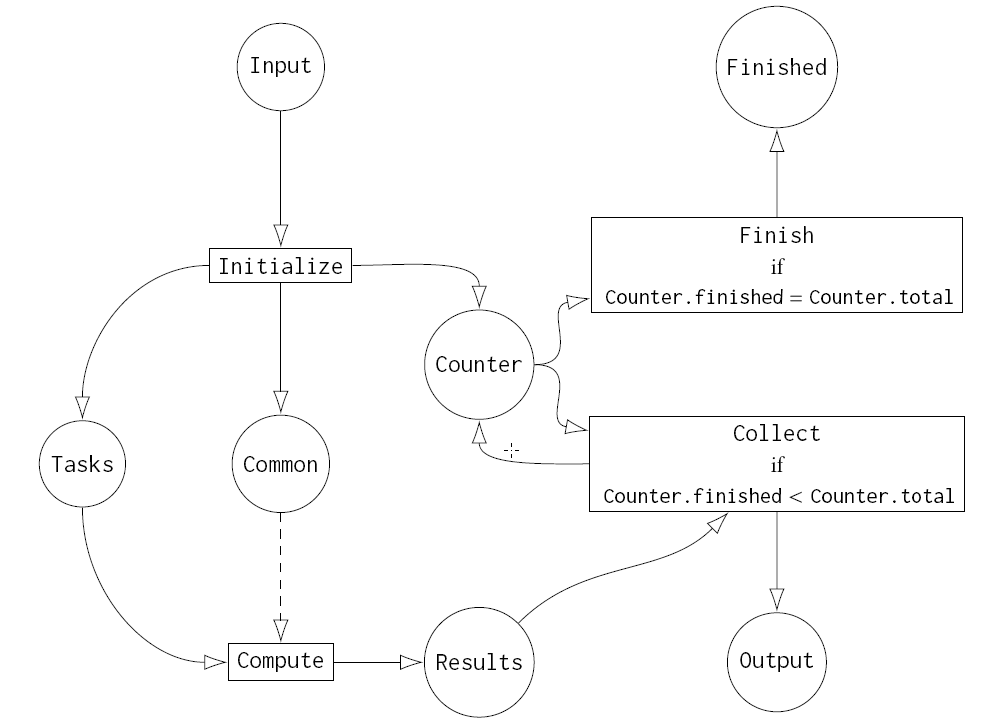 In the
In the  Multivariate partial fractioning is a powerful tool for simplifying
rational function coefficients in scattering amplitude computations.
Since current research problems lead to large sets of complicated
rational functions, performance of the partial fractioning as well as
size of the obtained expressions are a prime concern. In
Multivariate partial fractioning is a powerful tool for simplifying
rational function coefficients in scattering amplitude computations.
Since current research problems lead to large sets of complicated
rational functions, performance of the partial fractioning as well as
size of the obtained expressions are a prime concern. In

 In the paper
In the paper  In the paper
In the paper  In the paper
In the paper  In the paper
In the paper  In the paper
In the paper  The design and implementation of parallel algorithms is a fundamental task in
computer algebra. Combining the computer algebra system Singular and the
workflow management system GPI-Space, we have developed an infrastructure for
massively parallel computations in commutative algebra and algebraic geometry.
In the note
The design and implementation of parallel algorithms is a fundamental task in
computer algebra. Combining the computer algebra system Singular and the
workflow management system GPI-Space, we have developed an infrastructure for
massively parallel computations in commutative algebra and algebraic geometry.
In the note  Introducing parallelism and exploring its use is still a fundamental
challenge for the computer algebra community. In high performance numerical
simulation, transparent environments for distributed
computing which follow the principle of separating coordination and computation
have been a success story for many years. In the paper
Introducing parallelism and exploring its use is still a fundamental
challenge for the computer algebra community. In high performance numerical
simulation, transparent environments for distributed
computing which follow the principle of separating coordination and computation
have been a success story for many years. In the paper  In the paper
In the paper  In this paper
In this paper  Integration-by-parts identities between loop integrals arise from the
vanishing integration of total derivatives in dimensional regularization.
Generic choices of total derivatives in the Baikov or parametric
representations lead to identities which involve dimension shifts. These
dimension shifts can be avoided by imposing a certain constraint on the total
derivatives. The solutions of this constraint turn out to be a specific type of
syzygies which correspond to logarithmic vector fields along the Gram
determinant formed of the independent external and loop momenta. In the paper
Integration-by-parts identities between loop integrals arise from the
vanishing integration of total derivatives in dimensional regularization.
Generic choices of total derivatives in the Baikov or parametric
representations lead to identities which involve dimension shifts. These
dimension shifts can be avoided by imposing a certain constraint on the total
derivatives. The solutions of this constraint turn out to be a specific type of
syzygies which correspond to logarithmic vector fields along the Gram
determinant formed of the independent external and loop momenta. In the paper  Computations over the rational numbers often suffer from intermediate coefficient
swell. One solution to this problem is to apply the
given algorithm modulo a number of primes and then lift
the modular results to the rationals. This method is
guaranteed to work if we use a sufficiently large set
of good primes. In many applications, however, there
is no efficient way of excluding bad primes. In the
paper
Computations over the rational numbers often suffer from intermediate coefficient
swell. One solution to this problem is to apply the
given algorithm modulo a number of primes and then lift
the modular results to the rationals. This method is
guaranteed to work if we use a sufficiently large set
of good primes. In many applications, however, there
is no efficient way of excluding bad primes. In the
paper  V.I. Arnold has described normal forms and has developed a classifier for,
in particular, all isolated hypersurface singularities
over the complex numbers up to modality 2. Building
on a series of 105 theorems, this classifier determines
the type of the given singularity. However, for positive
modality, this does not fix the right equivalence class
of the singularity, since the values of the moduli parameters
are not specified. In the paper
V.I. Arnold has described normal forms and has developed a classifier for,
in particular, all isolated hypersurface singularities
over the complex numbers up to modality 2. Building
on a series of 105 theorems, this classifier determines
the type of the given singularity. However, for positive
modality, this does not fix the right equivalence class
of the singularity, since the values of the moduli parameters
are not specified. In the paper  Based on an idea in Hironaka's proof of resolution of singularities, we present in
Based on an idea in Hironaka's proof of resolution of singularities, we present in  In the paper
In the paper  In
In  In
In  In
In  3D
printing and other layer manufacturing processes are
challenged by dimensional accuracy. In
3D
printing and other layer manufacturing processes are
challenged by dimensional accuracy. In  Mirror symmetry relates Gromov-Witten invariants of an elliptic curve with
certain integrals over Feynman graphs. In
Mirror symmetry relates Gromov-Witten invariants of an elliptic curve with
certain integrals over Feynman graphs. In  Normalization is a fundamental ring-theoretic operation; geometrically it
resolves singularities in codimension one. Existing algorithmic methods for
computing the normalization rely on a common recipe: successively enlarge the
given ring in form an endomorphism ring of a certain (fractional) ideal until
the process becomes stationary. While Vasconcelos' method uses the dual
Jacobian ideal, Grauert-Remmert-type algorithms rely on so-called test ideals.
Normalization is a fundamental ring-theoretic operation; geometrically it
resolves singularities in codimension one. Existing algorithmic methods for
computing the normalization rely on a common recipe: successively enlarge the
given ring in form an endomorphism ring of a certain (fractional) ideal until
the process becomes stationary. While Vasconcelos' method uses the dual
Jacobian ideal, Grauert-Remmert-type algorithms rely on so-called test ideals.
 In
In
 Let A contained in B be cancellative abelian semigroups, and let R be an
integral domain. We show that the semigroup ring R[B] can be decomposed, as an
R[A]-module, into a direct sum of R[A]-submodules of the quotient ring of R[A].
In the case of a finite extension of positive affine semigroup rings we obtain
an algorithm computing the decomposition. When R[A] is a polynomial ring over a
field we explain how to compute many ring-theoretic properties of R[B] in terms
of this decomposition. In particular we obtain a fast algorithm to compute the
Castelnuovo-Mumford regularity of homogeneous semigroup rings. As an
application we confirm the Eisenbud-Goto conjecture in a range of new cases.
Our algorithms are implemented in the Macaulay2 package
Let A contained in B be cancellative abelian semigroups, and let R be an
integral domain. We show that the semigroup ring R[B] can be decomposed, as an
R[A]-module, into a direct sum of R[A]-submodules of the quotient ring of R[A].
In the case of a finite extension of positive affine semigroup rings we obtain
an algorithm computing the decomposition. When R[A] is a polynomial ring over a
field we explain how to compute many ring-theoretic properties of R[B] in terms
of this decomposition. In particular we obtain a fast algorithm to compute the
Castelnuovo-Mumford regularity of homogeneous semigroup rings. As an
application we confirm the Eisenbud-Goto conjecture in a range of new cases.
Our algorithms are implemented in the Macaulay2 package  In
the joint work
In
the joint work  In
the joint work
In
the joint work  This
is
an extensive project in progress to provide in the computer
algebra system
This
is
an extensive project in progress to provide in the computer
algebra system  Via
tropical geometry, toric geometry, Gröbner bases and
deformation theory a general framework for mirror
symmetry of Calabi-Yau varieties leading to an
algorithmic mirror construction is developed in
my PhD thesis. The tropical mirror
construction comes with a natural mirror map identifying
deformations and divisors. It reproduces the construction
by Batyrev for hypersurfaces, the generalization
thereof by Batyrev and Borisov to complete
intersections and a construction by Roedland
for a particular non-complete intersection Pfaffian Calabi-Yau 3-fold.
We also obtain a new mirror by applying the construction
to the non-complete intersection Pfaffian
Calabi-Yau 3-fold of degree 13 in projective 6-space.
Via
tropical geometry, toric geometry, Gröbner bases and
deformation theory a general framework for mirror
symmetry of Calabi-Yau varieties leading to an
algorithmic mirror construction is developed in
my PhD thesis. The tropical mirror
construction comes with a natural mirror map identifying
deformations and divisors. It reproduces the construction
by Batyrev for hypersurfaces, the generalization
thereof by Batyrev and Borisov to complete
intersections and a construction by Roedland
for a particular non-complete intersection Pfaffian Calabi-Yau 3-fold.
We also obtain a new mirror by applying the construction
to the non-complete intersection Pfaffian
Calabi-Yau 3-fold of degree 13 in projective 6-space. Consider a rational curve C in
projective 2-space with rational coefficients.
If the degree of C is odd then there is a
parametrization of C with rational coefficients. If the
degree is even then there is a parametrization
with coefficients in the rational numbers or a field
extension thereof of degree 2.
Consider a rational curve C in
projective 2-space with rational coefficients.
If the degree of C is odd then there is a
parametrization of C with rational coefficients. If the
degree is even then there is a parametrization
with coefficients in the rational numbers or a field
extension thereof of degree 2.